Pollen Universe
The hand-colored SEM images of pollen assembled on this picture illustrate the fascinating diversity. Pollen grains evolved in plants to airfreight the male genome and the tiny carriers are remarkably diverse with variations in size from 6 to 250 μm. This award-winning series contains many iconic images was carefully collected and produced over more than a decade. Over the years both, extracts and single works have been published by the greatest names in science and photography. Documenting pollen diversity represents Micronaut’s earliest project and it is still ongoing.
First illustrations of pollen grains start in the 17th century, shortly after the development of the first light microscope. At the end of the 19th century most characteristics of the capsule structure have already been established. One and a half centuries later, invention and commercialization of scanning-electron-microscopy (SEM) allow fascinating new insights into the microcosm and re- initiate pollen research.
«I greatly admire your innovative work.»
Ai Weiwei
Artistic Director, 2011 Gwangju Design Biennale
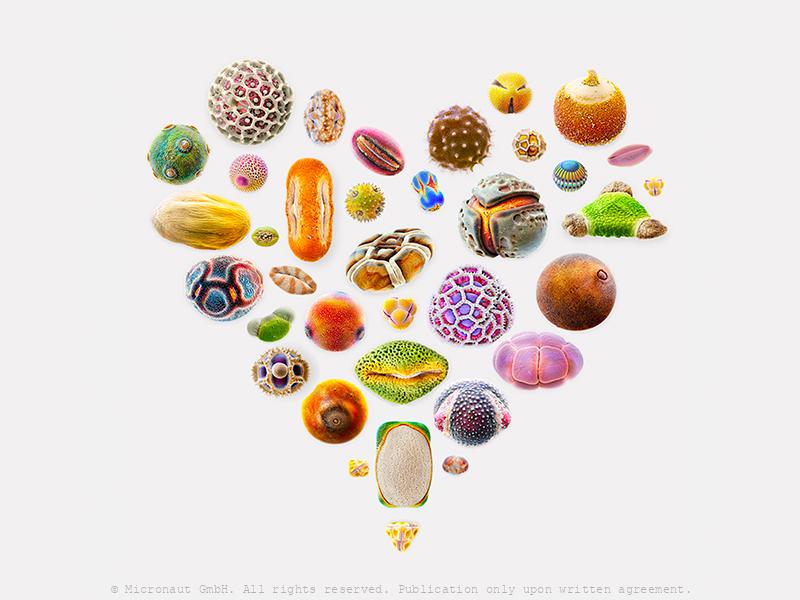
Valentine's Day - Assortment of pollen grains
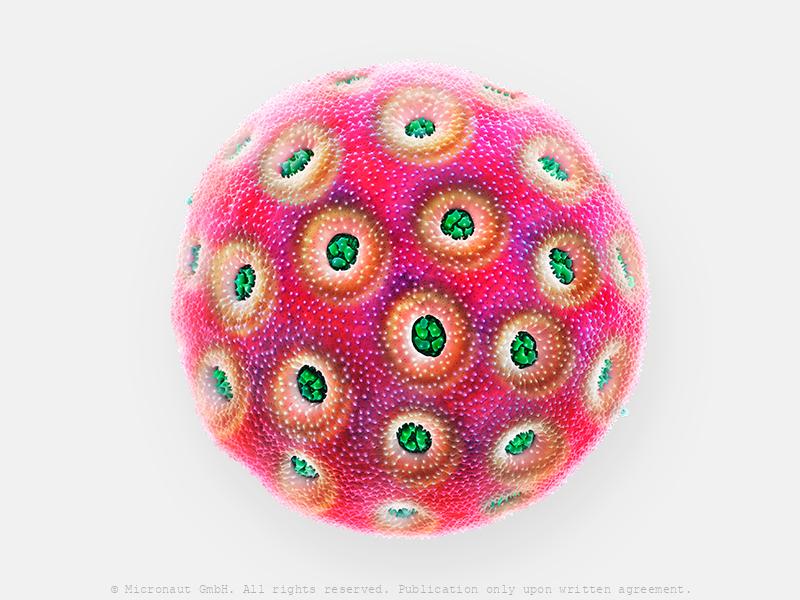
Tape Amaranth pollen grain (Amaranthus sp.)
Amaranth (Amaranthus sp.) pollen grain. Pollen is a fine to coarse powder consisting of microgametophytes (=pollen grains), which produce the male gametes (sperm cells) of seed plants. Insect pollinated plants produce relatively low numbers of pollen grains compared to wind pollinated species. Each plant species has pollen grains that are unique due to the meticulous processes of evolution. While some have only one aperture (pre-formed opening to let the pollen tube exit), others may have three, six, or even double and triple the number. To have many pre-formed openings is assumed to be a more modern development: it allows the delicate pollen tube to emerge and dive right into the pistil tissue, without having to grow over an extensive stretch while being exposed to UV radiation, heat and other stress factors that could lead to damage of the tube and male gametes. Oeggerli slowly breathes life into his works by manually highlighting different structures with colors, layer upon layer on his laptop. The process allows him to set focus on the mysterious diversity and hidden morphological structures of pollen grains. by Martin Oeggerli and Louisa Howard, Microscopy Facility, Dartmouth College.
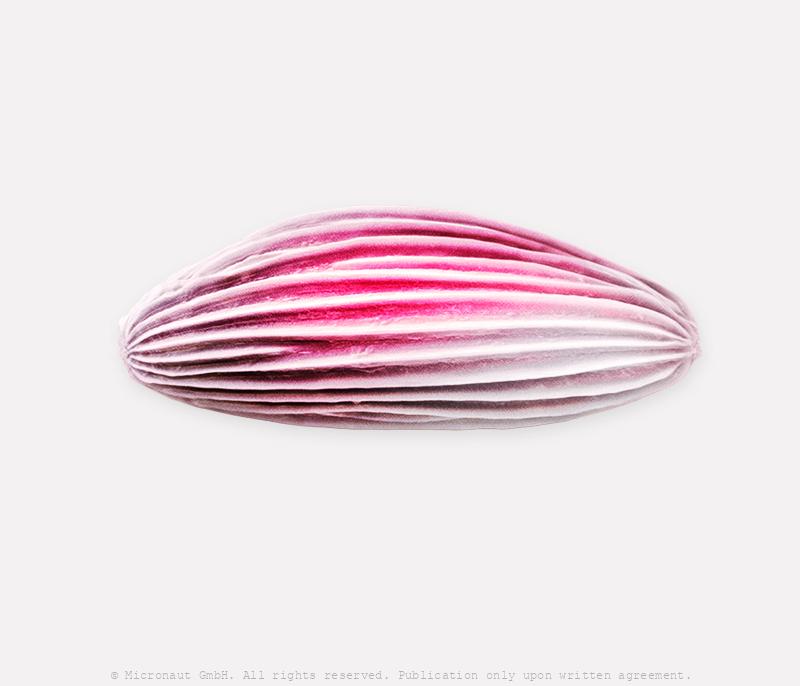
Water Cabbage Pollen (Pistia sp.)
Water cabbage (Pistia sp.) is an invasive plant and was first described from Nile close to lake Victoria. Despite a tiny flower, the pollen is a medium sized elliptic monad covered with equatorial crests, which are rarely found features in the pollen universe.
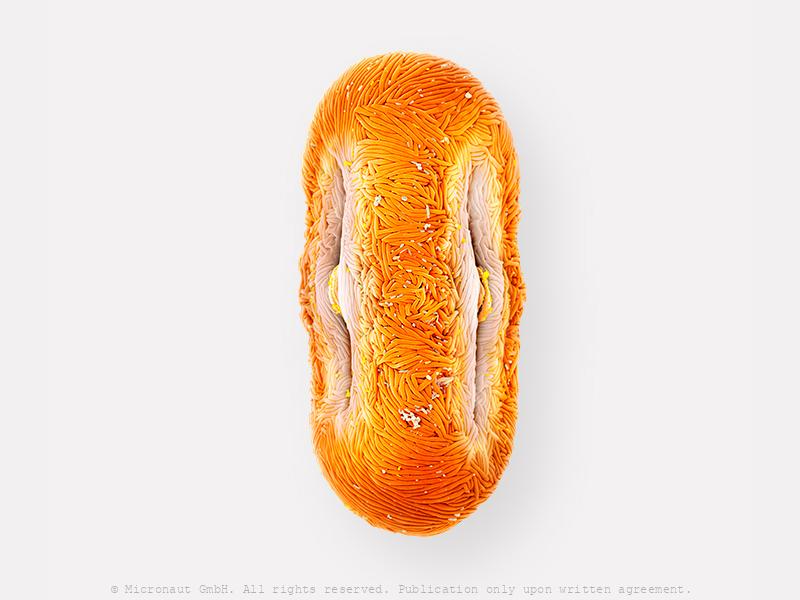
Dill pollen (Anethum graveolens)
Dill (Anethum graveolens) pollen grain. It's an elongated, relatively small to medium size pollen grain featuring three apertures (i.e. pre-formed openings for exit of the pollen tube). Pollen grain by Martin Oeggerli and Louisa Howard, Microscopy Facility, Dartmouth College.
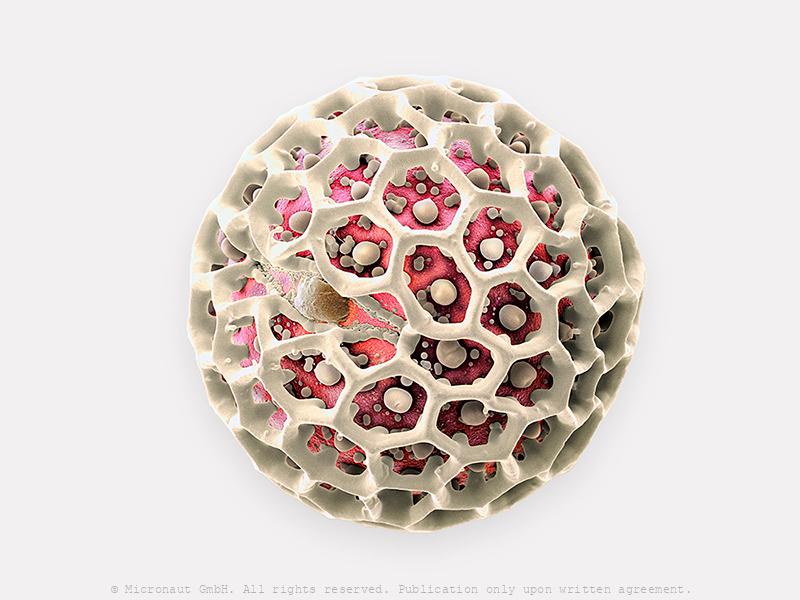
Eranthemum pollen grain
This is an especially beautiful pollen grain from a Spring Flower! By Martin Oeggerli (Micronaut), supported by H Halbritter and PalDat, Dep. Botany and Biodiversity, University Vienna.
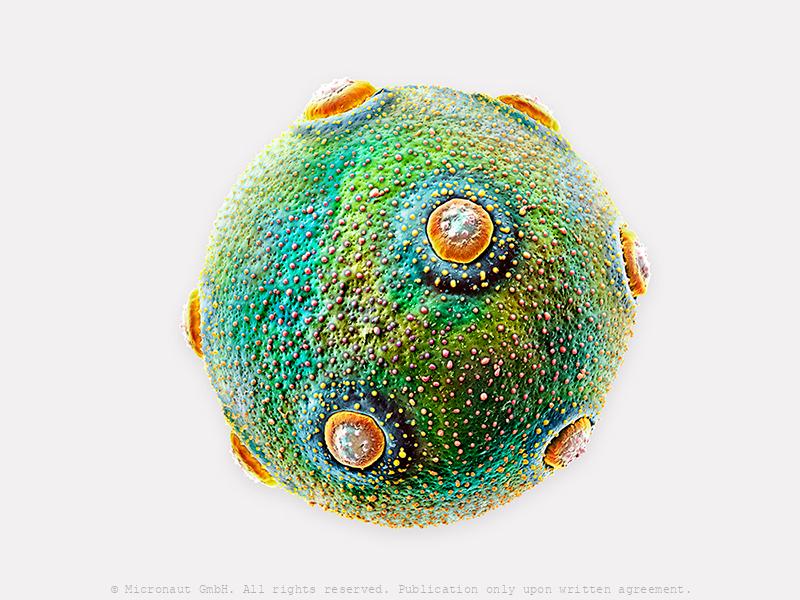
Plantain Pollen - The Dymaxion Principle
Pollen of Plantago sp. which has a rather graphical shape, much like the Dymaxion principle by renowned architect and futurist inventor Richard Buckminster ("Bucky") Fuller. Artistic coloration of a Plantain (Plantage sp.) pollen grain. Wind pollinated Plantain produces thousands of pollen grains to ensure successful fertilization. In contrast to other plant species, the Plantain pollen grain is equipped with a multitude of openings, called apertures, which are enabling the pollen tube to leave his protective jacket. Oeggerli slowly breathes life into his works by painstakingly selecting and masking different structures with color, layer upon layer utilizing his laptop touchpad. The process allows him to set focus on the mysterious structures of this invisibly small and allergenic Plantain pollen.
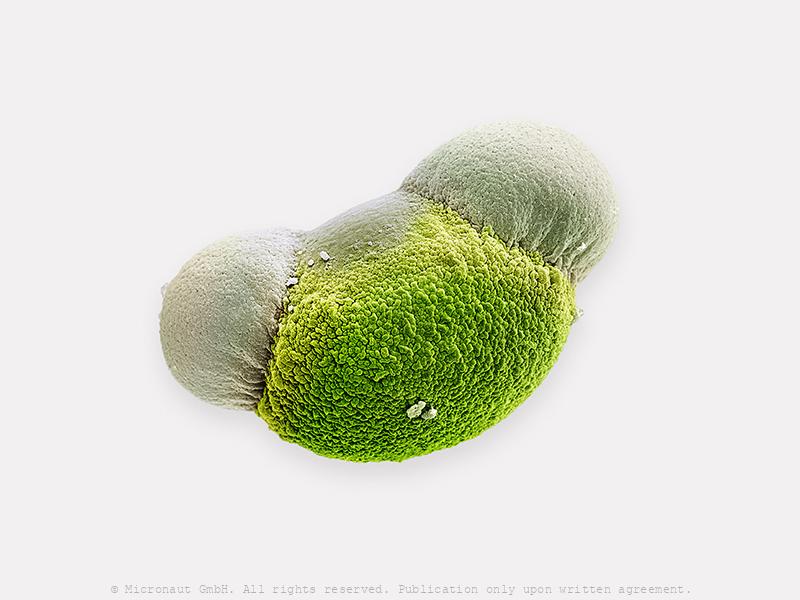
The colossal Pine pollen
Pollen grains are stunningly beautiful and remarkably diverse. The size varies from 10 to 250 µm. To be carried more easily by the wind, the pine pollen capsule is equipped with two light balloon-like envelopes. By Martin Oeggerli (Micronaut), supported by H Halbritter and PalDat, Dep. Botany and Biodiversity, University Vienna.
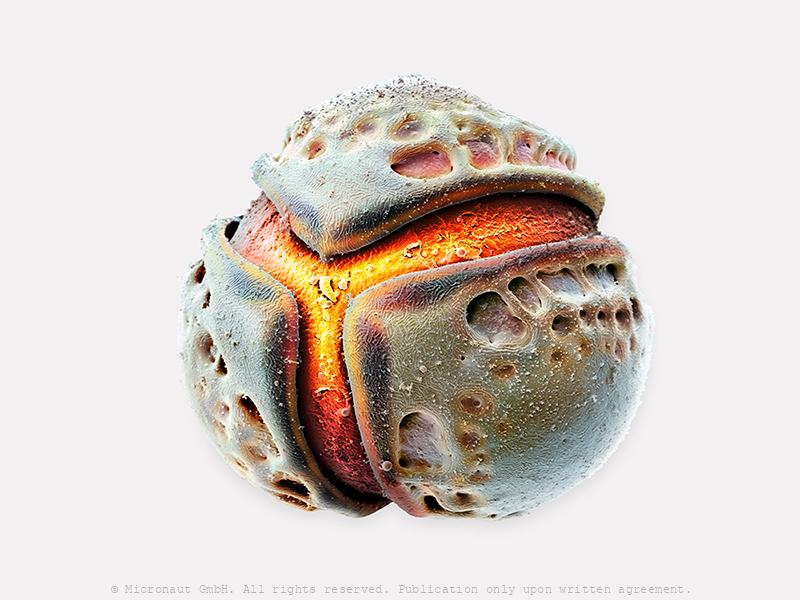
Pollen grain of the Fish-poison tree (Barringtonia sp.)
Their size is measured in millionths of a meter, but the romantic journeys of pollen are epic: this spectacular pollen grain belongs to the Fish-poison tree, or Putat tree (Barringtonia asiatica). The flowers open during evening-night time during which bats and hawk moths swiftly visit for nectar collection, effecting in both self- and cross-pollination. Pollen grains are spherical with three apertures and feature an ornamented exine surface. Coloured scanning electron micrograph (SEM) by Martin Oeggerli (Micronaut), supported by Pathology, University Hosp. Basel, C-CINA, Biozentrum, University Basel, and H Halbritter and PalDat, Dep. Botany and Biodiversity, University Vienna.
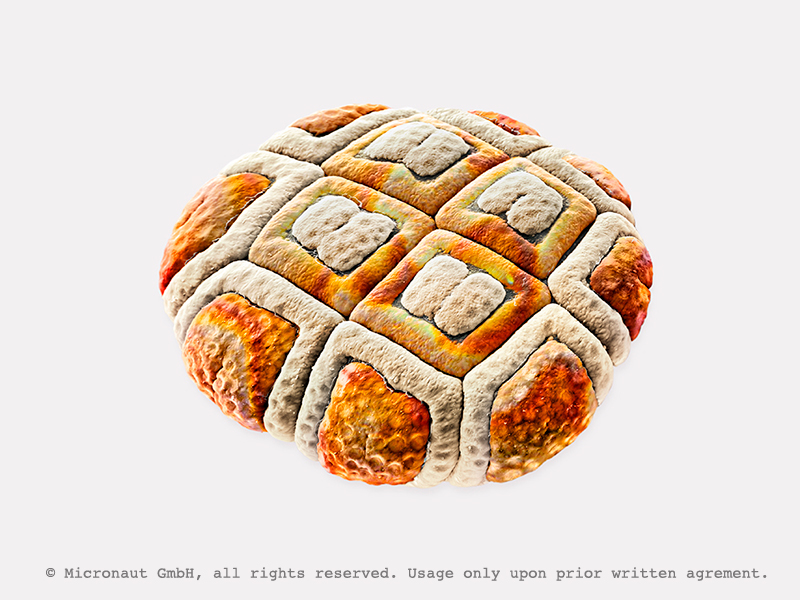
©-Micronaut-Pollen-Acacia-001028
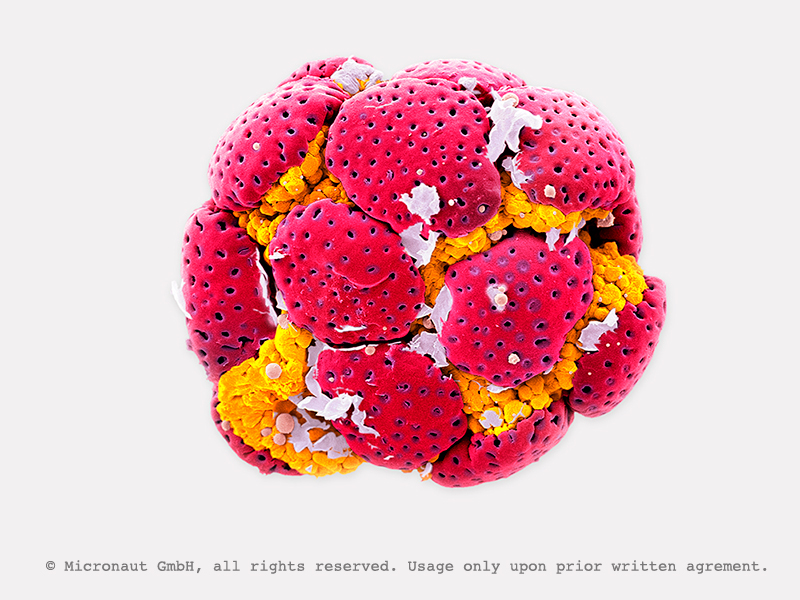
Cymbopetalum pollen grain (Cymbopetalum aequale)
Cymbopetalum pollen grain (Cymbopetalum aequale), unusual morphology
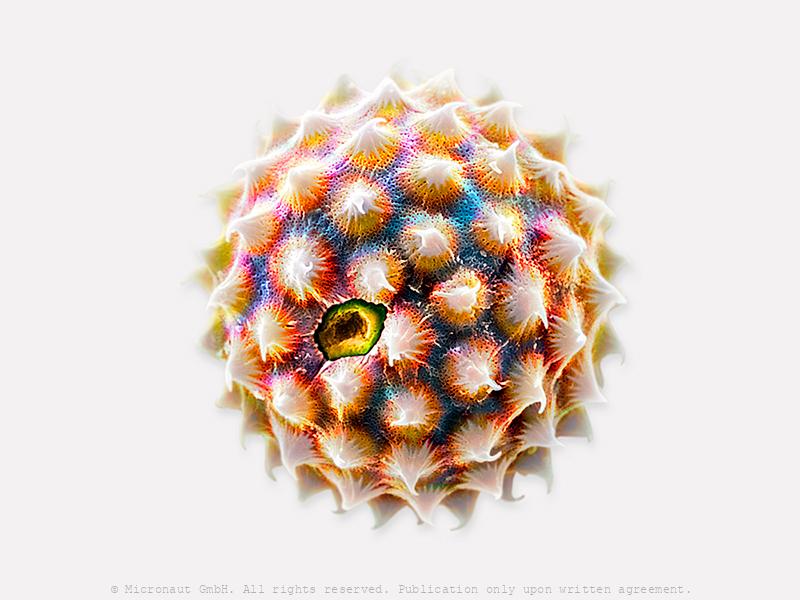
Ragweed pollen grain (Ambrosia artemisiifolia)
The world's most allergic pollen grain: Ragweed (Ambrosia artemisiifolia), a rather unremarkable plant holds a stupefying record. It produces 1.6 million highly allergic pollen per hour, thereby knocking-out hayfever sufferers all around the world... The weed from North America was introduced into Europe and spreads. QUELLE: Artwork by M Oeggerli (Micronaut 2023) and ZAUM- Center of Allergy & Environment (SEM).
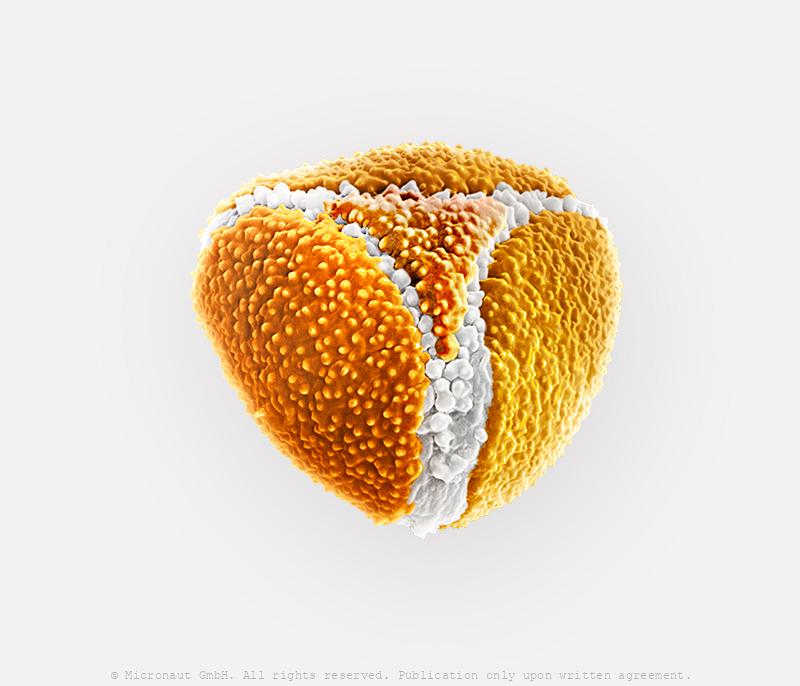
Aponogeton pollen (Aponogeton sp.)
Aponogeton angustifolius is a freshwater aquatic, with small, ornamental floating leaves and delicate, short sprays of white flowers. It is becoming increasingly threatened in the wild. Oldest fossil pollen from the genus date back to the late cretaceous, 84 mio years ago. The aperture of this pollen grain is hidden (sunken) and it's just one. Sometimes, the pollen drift on the water surface to eventually fertilize another flower...
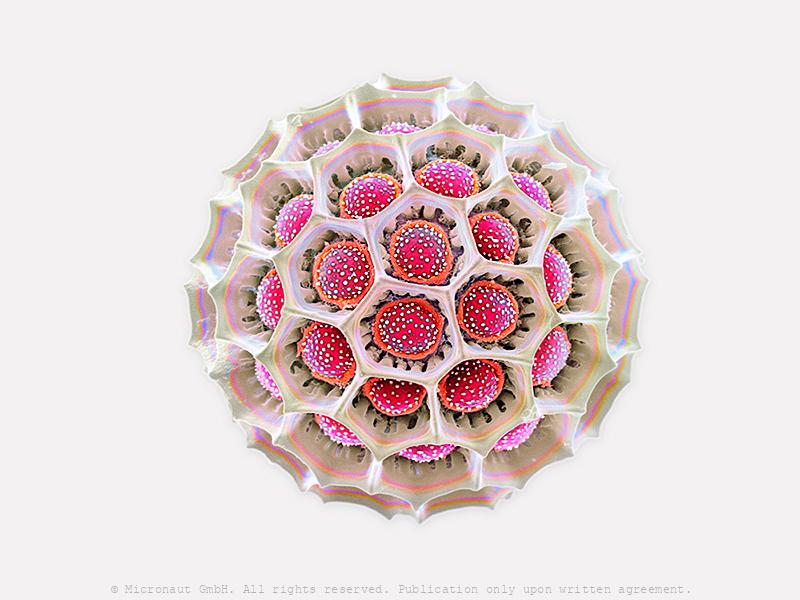
Globe Amaranth pollen (Gompherena globosa)
Globe Amaranth pollen (Gompherena globosa) Pollen is a fine to coarse powder consisting of microgametophytes (=pollen grains), which produce the male gametes (sperm cells) of seed plants. Insect pollinated plants produce relatively low numbers of pollen grains compared to wind pollinated species. Each plant species has pollen grains that are unique due to the meticulous processes of evolution. While some have only one aperture (pre-formed opening to let the pollen tube exit), others may have three, six, or even double, thriple, or quadruple that number (app. 72 in this case!!). To have many pre-formed openings, as in this species, is assumed to be a modern trait: it allows the delicate pollen tube to dive right into the pistil tissue, as soon as it emerges through the exine (=outer shell of the pollen grain). Avoiding exposure to UV radiation, heat and other stress factors, that could potentially harm the male gametes that are exposed inside the delicate pollen tube as soon as it emerges from the capsule increases the reproductive success of the plant. Oeggerli slowly breathes life into his works by manually highlighting different structures with colors, layer upon layer on his laptop. The process allows him to set focus on the mysterious diversity and hidden morphological structures of pollen grains.
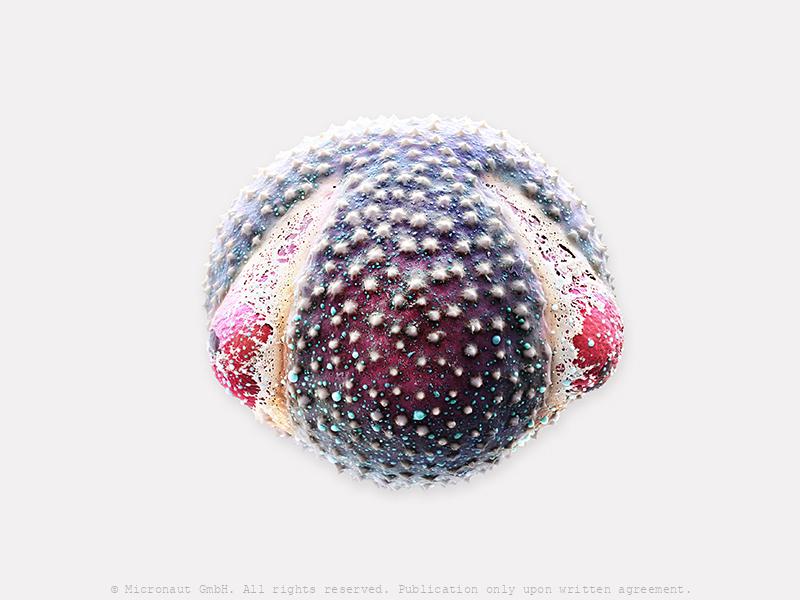
Oak pollen (Quercus petraea)
Pollen is a fine to coarse powder consisting of microgametophytes (=pollen grains), which produce the male gametes (sperm cells) of seed plants. Wind pollinated plants have to make billions of pollen grains if one might succeed - it's an intimate improbably lottery! A hard coat covering the pollen grain protects the sperm cells during the process of their movement between the stamens of the flower to the pistil of the next flower. Pollen grain morphology is breathtakingly divers. Wind pollinating plants generally produce small grains with a smooth surface, thereby increasing the probability of successful fertilization. Oeggerli slowly breathes life into his works by painstakingly selecting different structures with different colors, layer upon layer on his laptop. The process allows him to set focus on the mysterious structures of this highly allergenic oak (Quercus petraea) pollen. To travel many 1000 kilometers, wind-pollinated oak pollen are leight-weight constructions with a smooth and non-sticky surface, in order to be carried over large distances.
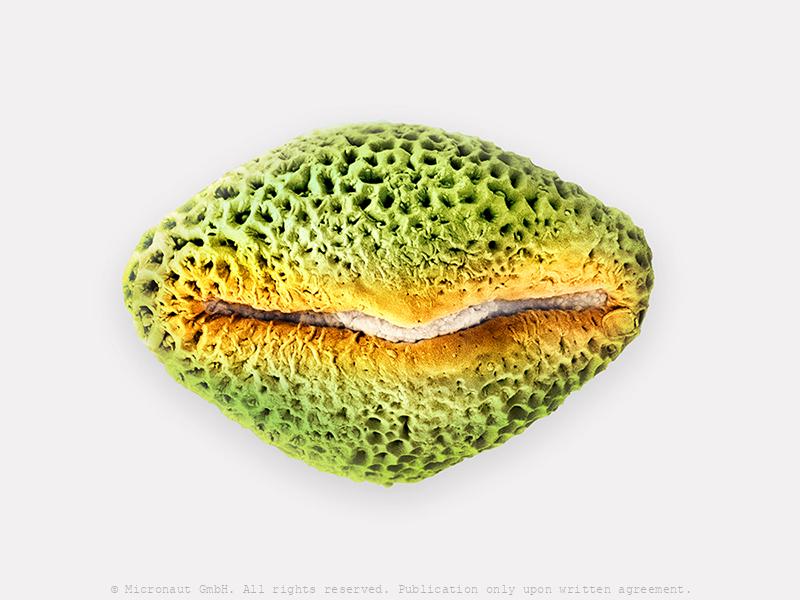
Hydrated Tulip pollen grain
The germinating Tulip (Tulipa sp.) pollen with a length of 41.0 micrometers has just initialized the process of pollen tube formation.
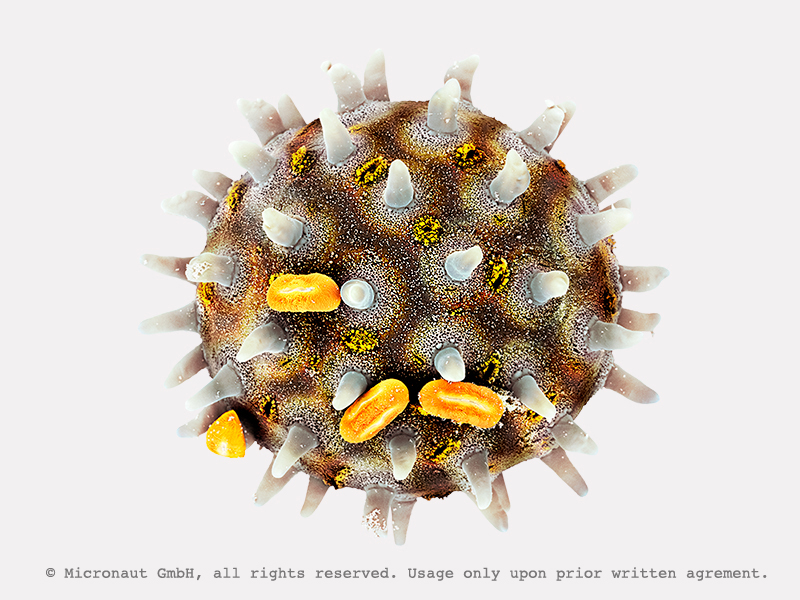
David versus Goliath (Pollen grains of Hibiscus sp., and Anethum
Hibiscus (Hibiscus sp.) pollen grain with four Dill (Anethum graveolens) pollen sticking to its surface. Hibiscus blossoms are brightly colored and open wide, attracting pollinators from bees to hummingbirds to reach in for a deep drink of nectar. As they do, they inevitably make contact with the flower's prominent stamen and pistil, aiding in the plant's pollination and subsequent fertilization. The pollen of Hibiscus is one of the largest that you can find in the pollen universe and it cannot be transported by the wind. Instead, it relies on elongated spikes on the surface, which are considered a characteristic adaptation to insect (& bird) pollination, to facilitate its attachment to hairs and feathers. Since Hibiscus pollen are far too heavy to be dispersed by the wind, it cannot be considered an allergenic threat. However, if you are extra sensitive you may want to avoid Hibiscus tea as it can contain irritants.
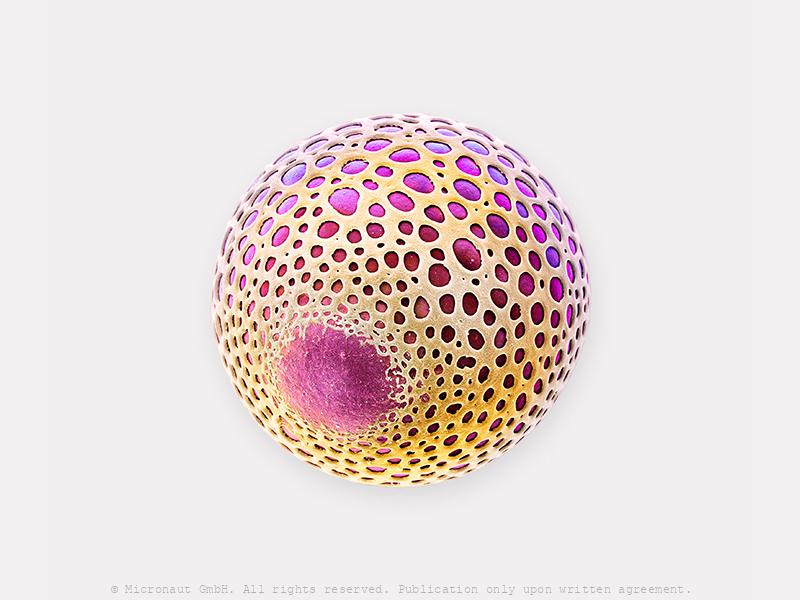
Pollen (Wittrockia cyanthiformis)
Pollen is a fine to coarse powder consisting of microgametophytes (=pollen grains), which produce the male gametes (sperm cells) of seed plants. Wind pollinated plants have to make billions of pollen grains if one might succeed - it's an intimate improbably lottery! By Martin Oeggerli (Micronaut),supported by H Halbritter and PalDat, Dep. Botany and Biodiversity, University Vienna.
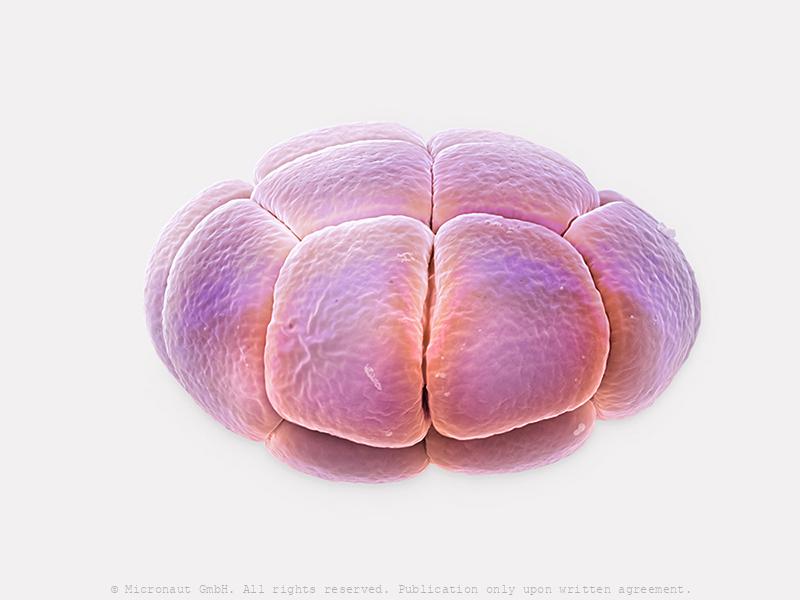
Albizia julibrissin
While the conventional pollen is a perfect whole, no suitable term exists for this unusually shaped pollen grain. The Persian Silk Tree and its relatives from the Acacia- family have evolved complex pollen made of many different parts. The image shows a pollen sticking to an anther. Mimosa (Albizia julibrissin) has been used for many years in Chinese Medicine to treat anxiety and depression, and its Chinese name He Huan Pi (Hua) translates to "collective happiness flower".
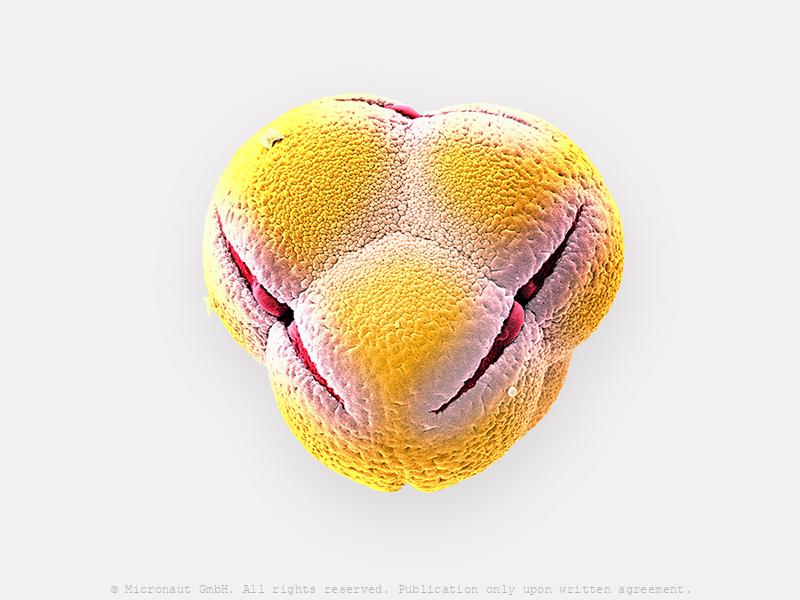
Erica pollen grain
By Martin Oeggerli (Micronaut), supported by H Halbritter and PalDat, Dep. Botany and Biodiversity, University Vienna.
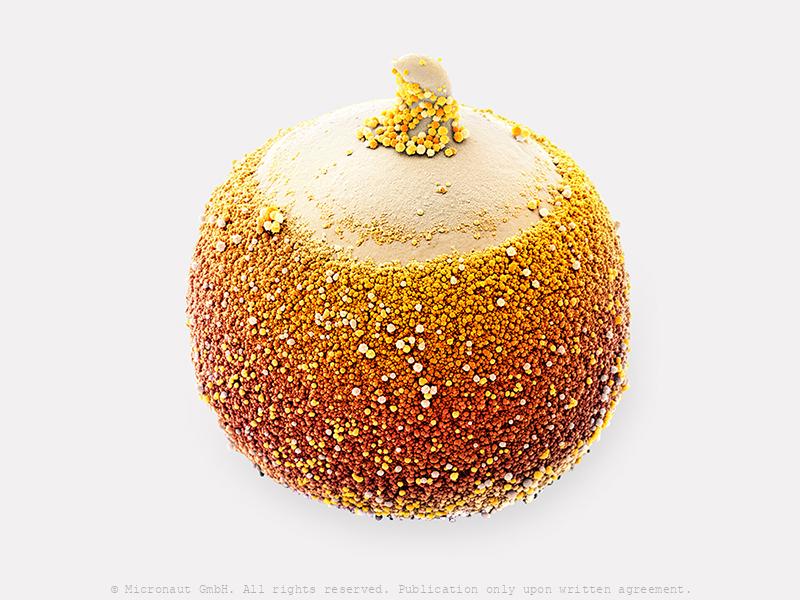
Cryptomeria japonica single pollen grain
Pollen grains with Ubisch bodies (yellow dots). The pollen grains belong to the Japanese Cedar (Cryptomeria japonica). They are highly allergic and go through major structural chenge when exposed to nasal discharge, exposing allergens from inside the pollen grain and from the Ubisch bodies.
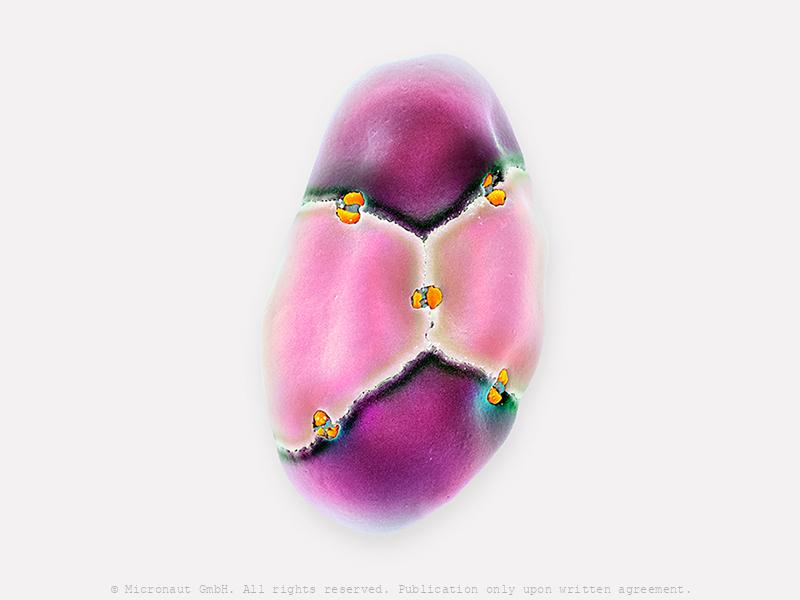
Silkvine pollen (Periploca gracilis)
Silkvine pollen (Periploca gracilis) Pollen is a fine to coarse powder consisting of microgametophytes (=pollen grains), which produce the male gametes (sperm cells) of seed plants. Insect pollinated plants produce relatively low numbers of pollen grains compared to wind pollinated species. Each plant species has pollen grains that are unique due to the meticulous processes of evolution. While in most cases pollen are single units, the Silkvine has developed tetrade grains (which contain four units). Multiple tetrads form more or less loosely connected aggregations of different shape and size and are not interpretable as pollinia (term used for pollen of orchids, where pollen grains form one large aggregation). Oeggerli slowly breathes life into his works by manually highlighting different structures with colors, layer upon layer on his laptop. The process allows him to set focus on the mysterious diversity and hidden morphological structures of pollen grains.
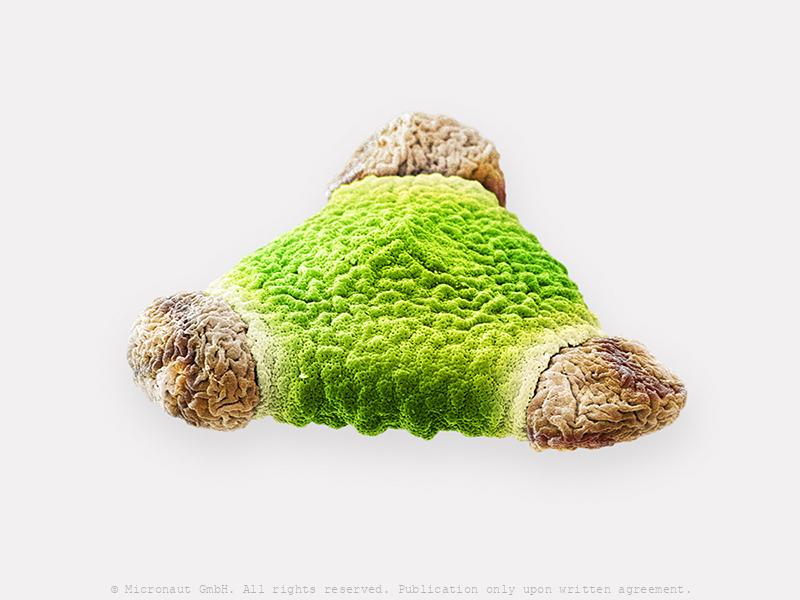
Hakea pollen grain (dry)
By Martin Oeggerli (Micronaut), supported by H Halbritter and PalDat, Dep. Botany and Biodiversity, University Vienna.
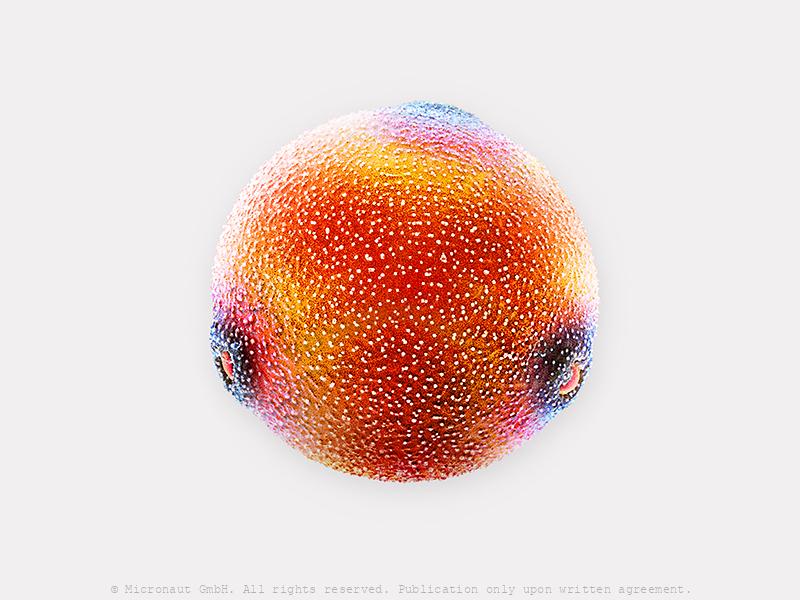
Birch pollen (Betula humilis)
Pollen grains are stunningly beautiful and remarkably diverse. The size varies from 10 to 250 µm. To be carried more easily by the wind, the Mountain birch pollen capsule is a lightweight construction. Oeggerli slowly breathes life into his works by painstakingly selecting different structures with different colors, layer upon layer on his laptop. The process allows him to set focus on the mysterious structures of this highly allergenic oak (Quercus petraea) pollen. To travel many 1000 kilometers, wind-pollinated birch pollen are leight-weight constructions with a smooth and non-sticky surface, in order to be carried over large distances. By Martin Oeggerli (Micronaut), supported by H Halbritter and PalDat, Dep. Botany and Biodiversity, University Vienna.
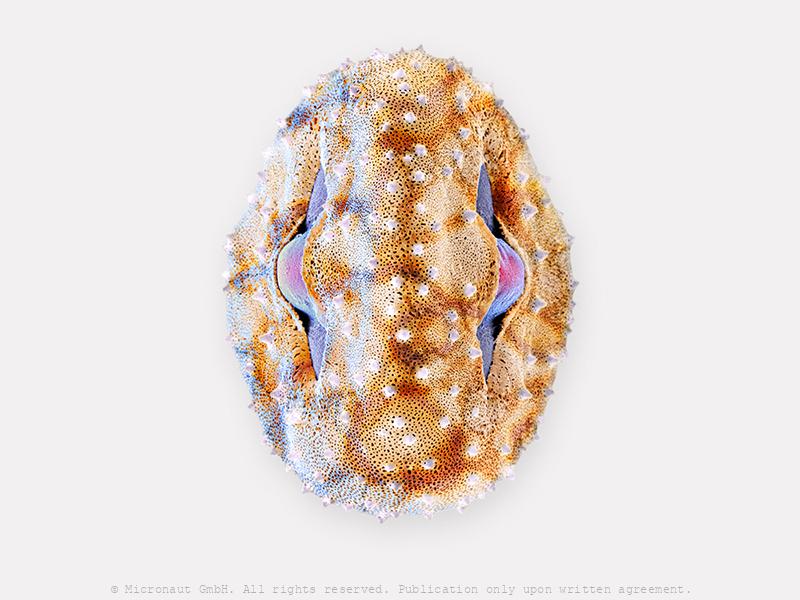
Echinops pollen grain
Pollen is a fine to coarse powder consisting of microgametophytes (=pollen grains), which produce the male gametes (sperm cells) of seed plants. A hard coat covering the pollen grain protects the sperm cells during the process of their movement between the stamens of the flower to the pistil of the next flower. Pollen grain morphology is breathtakingly divers. By Martin Oeggerli (Micronaut), supported by H Halbritter and PalDat, Dep. Botany and Biodiversity, University Vienna.
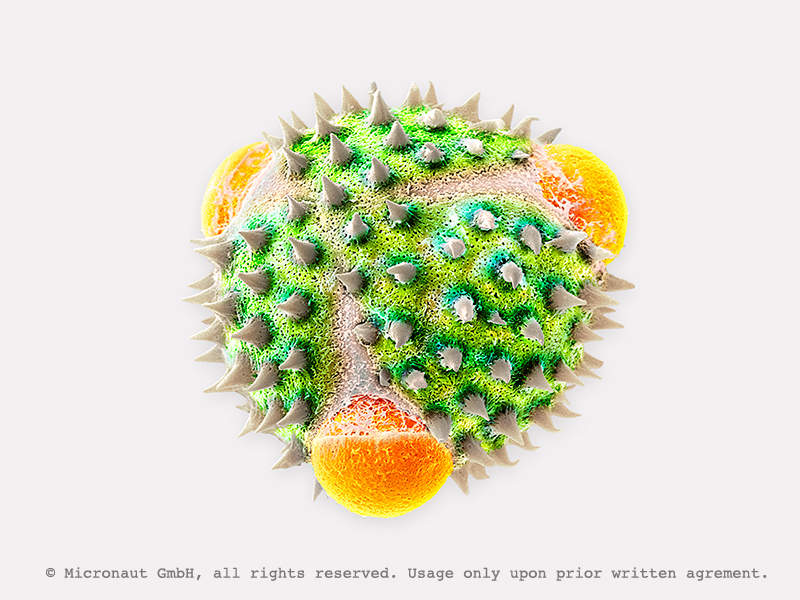
Edelweiss pollen grain (Leontopodium alpinum)
Edelweiss pollen grain (Leontopodium alpinum) JEOL, AccV/10.0; Mag/3300; Format/JEOL/MP; Detector/SED; WD/7.8; PC/41.9; Vac/HV; SRT/0; Time/20s
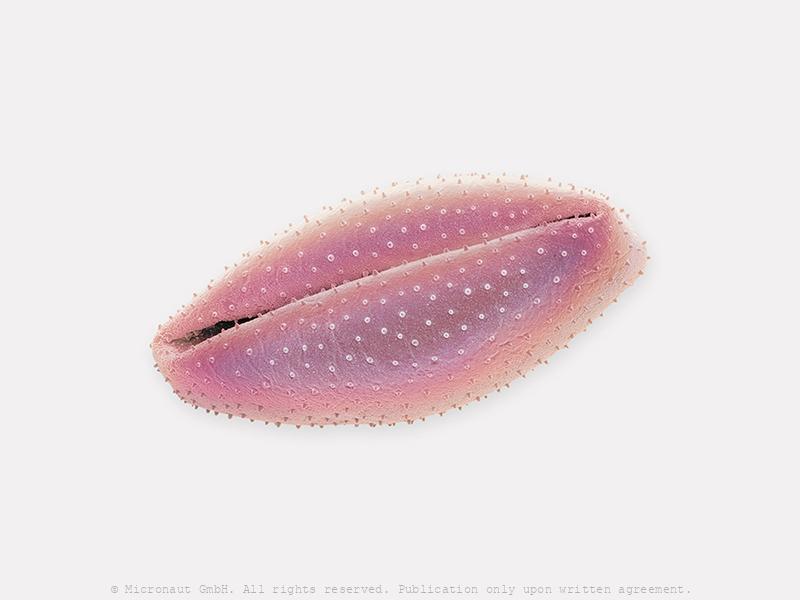
Pollen grain (Hakenlilie)
Pollen grain of a lily.
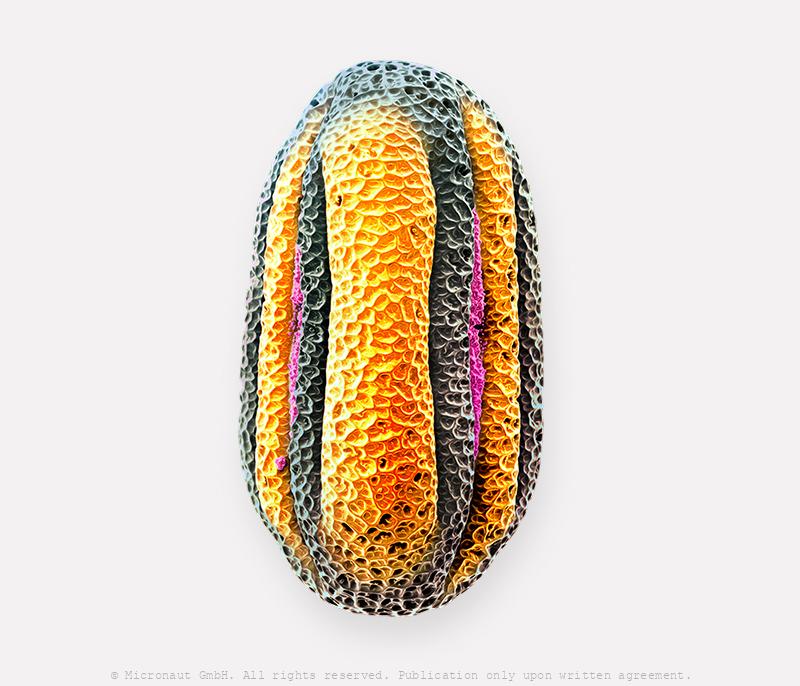
Pollen (unknown species)
Dry pollen grains often show preformed clefts that allow extreme volume changes accompanying desiccation and hydration. Some of them additionally serve as portals for pollen tube exit during germination and are called apertures.
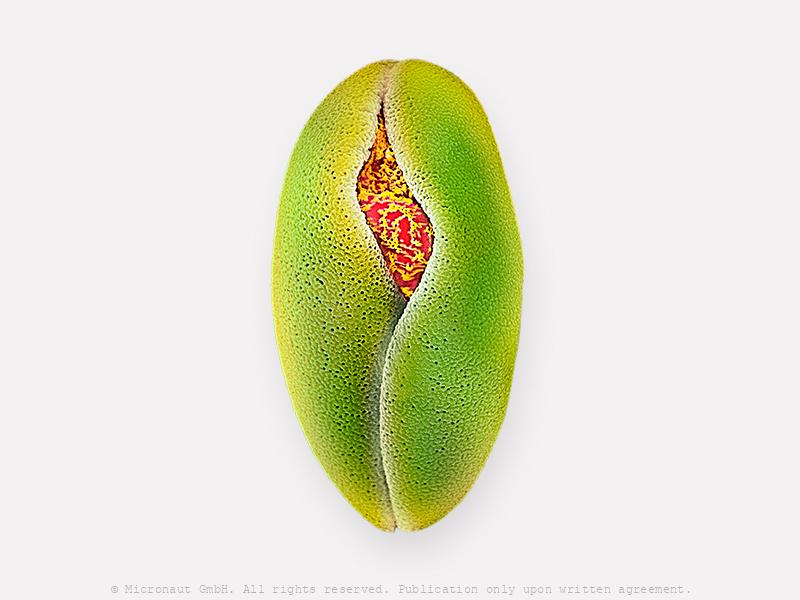
Snowdrop pollen (Galanthus nievalis)
Common snowdrop (Galanthus nievalis) is a typically wind pollinated plant. In early spring, the plant grow from bulbs –sometimes directly through snow- to open just a single flower. Pollen are oval shaped with a smooth surface.
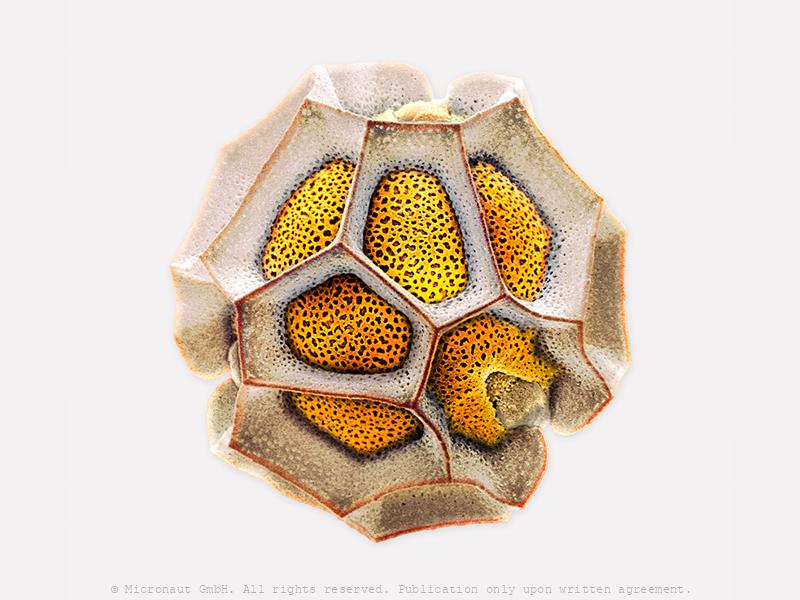
Messengers of Love
Messengers of Love (Gazania sp.) For much of the long history of green life on land, plants had to be near each other, touching almost, to mate. Moss lets its pale sperm into rainwater to float to nearby partners, as did other early plants, but this method requires moisture. Vegetation could only survive in those damp corners where beads of water connected, dependably, a male to a female. Most of the Earth was brown. Then, one day more than 375 million years ago, it happened. One lineage of plants evolved pollen grains and seeds, and from then on nothing was the same... plants developed an incredible diversity of pollen grains, because - each plant has it‘s own messengers of love.
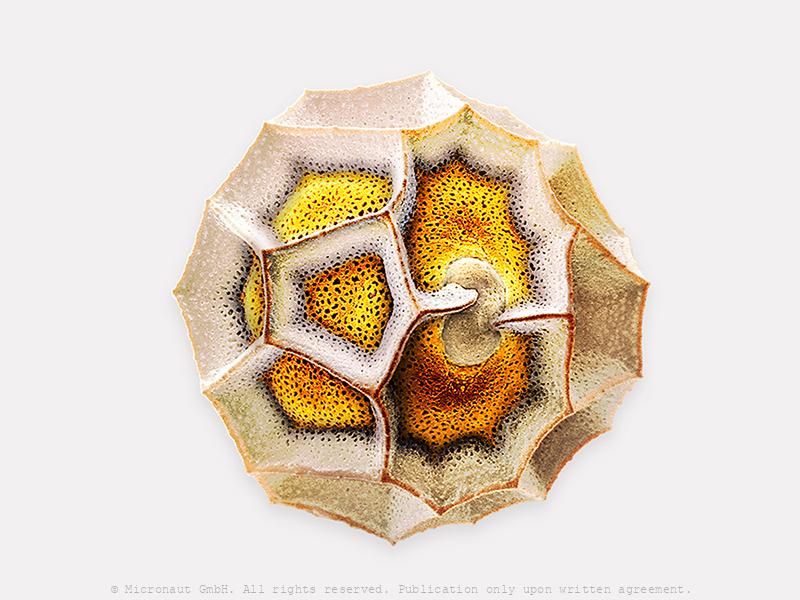
Gazania pollen grain
By Martin Oeggerli (Micronaut), supported by H Halbritter and PalDat, Dep. Botany and Biodiversity, University Vienna.
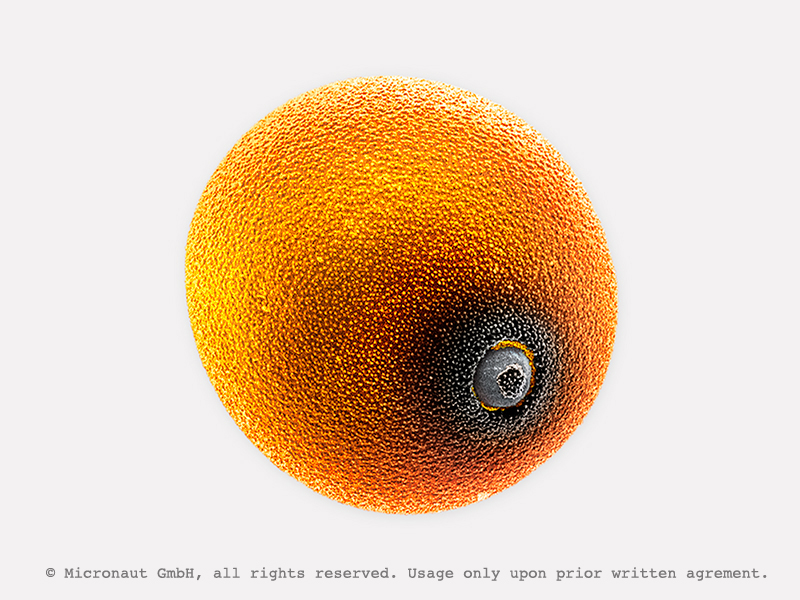
Grass pollen (Poa angustifolio)
Poa_pratensis_150405_06
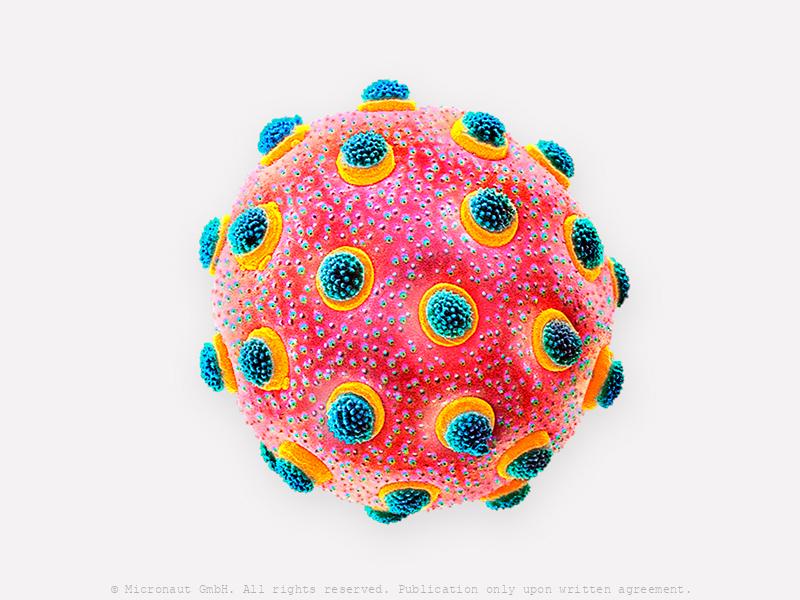
Cornockle pollen (Agrostemma githago)
Cornockle pollen grain (Agrostemma githago). Pollen is a fine to coarse powder consisting of microgametophytes (=pollen grains), which produce the male gametes (sperm cells) of seed plants. Insect pollinated plants produce relatively low numbers of pollen grains compared to wind pollinated species. Each plant species has pollen grains that are unique due to the meticulous processes of evolution. While some have only one aperture (pre-formed opening to let the pollen tube exit), others may have three, six, or even double, thriple, or quadruple that number. To have many pre-formed openings, as in this case, is assumed by scientists to be a modern trait: it allows the delicate pollen tube to dive right into the pistil tissue as soon as it emerges through the exine (=outer shell of the pollen grain), without having to grow over an extensive stretch. This minimizes the exposure to UV radiation, heat and other stress factors, that could potentially harm the male gametes, and thus lower the reproductive success of the plant. Oeggerli slowly breathes life into his works by manually highlighting different structures with colors, layer upon layer on his laptop. The process allows him to set focus on the mysterious diversity and hidden morphological structures of pollen grains. By Martin Oeggerli (Micronaut), supported by H Halbritter and PalDat, Dep. Botany and Biodiversity, University Vienna.
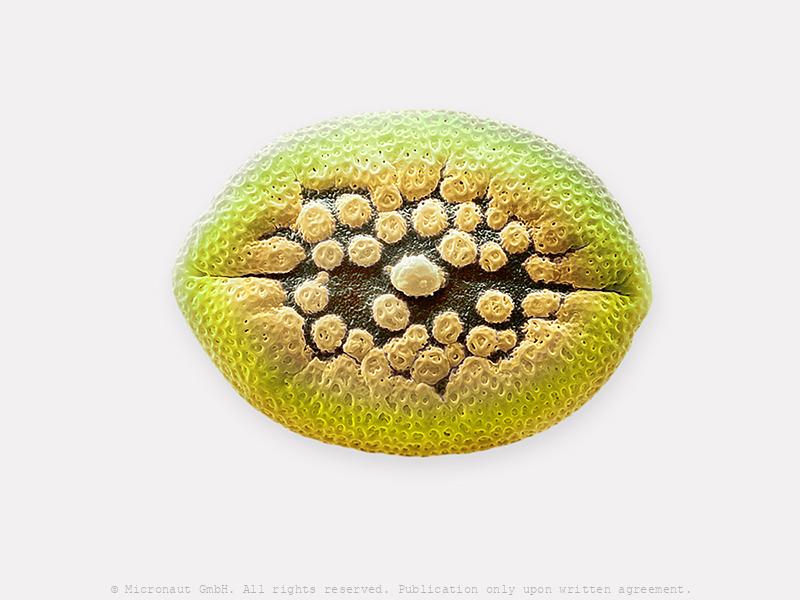
Justizia pollen grain
Pollen grain from a Justizia sp.
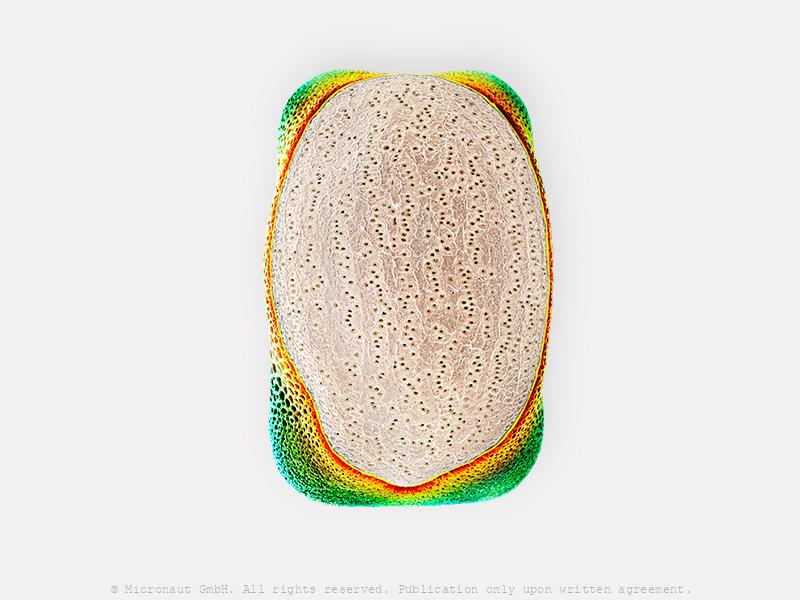
Foxtail Lily Pollen Grain (Eremurus robustus)
Pollen Grain of a Foxtail Lily (E. robustus). Pollen is a fine to coarse powder consisting of microgametophytes (=pollen grains), which produce the male gametes (sperm cells) of seed plants. Insect pollinated plants produce relatively low numbers of pollen grains compared to wind pollinated species. Oeggerli slowly breathes life into his works by manually highlighting different structures with colors, layer upon layer on his laptop. The process allows him to set focus on the mysterious diversity and hidden morphological structures of pollen grains. By Martin Oeggerli (Micronaut), supported by H Halbritter and PalDat, Dep. Botany and Biodiversity, University Vienna.
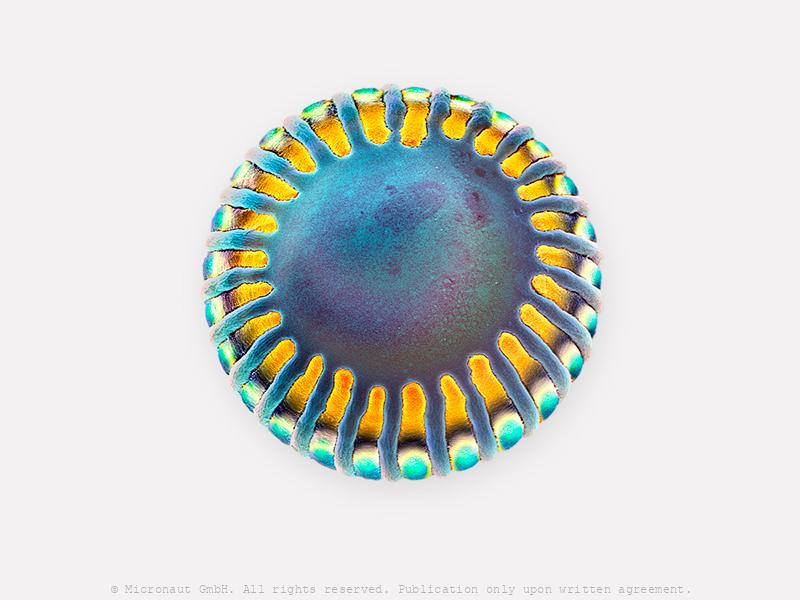
Sweet Pea Shrub Pollen (Polygala grandiflora) - I/III
This are pollen grains of the Sweet Pea Shrub (Polygala grandiflora), captured with a scanning-electron-microscope and subsequently hand-colored by science photographer Martin Oeggerli. The pollen grain of the Sweat Pea Shrub is equipped with a multitude of openings, called apertures, which are enabling the pollen tube to leave the protective jacket with only minimum distance to the pistil tissue. Oeggerli slowly breathes life into his works by selecting and masking different structures with color, layer upon layer utilizing the post-processing software on his computer. The process allows him to set focus on the mysterious structures of the invisibly small pollen grains. By Martin Oeggerli (Micronaut), supported by H Halbritter and PalDat, Dep. Botany and Biodiversity, University Vienna.
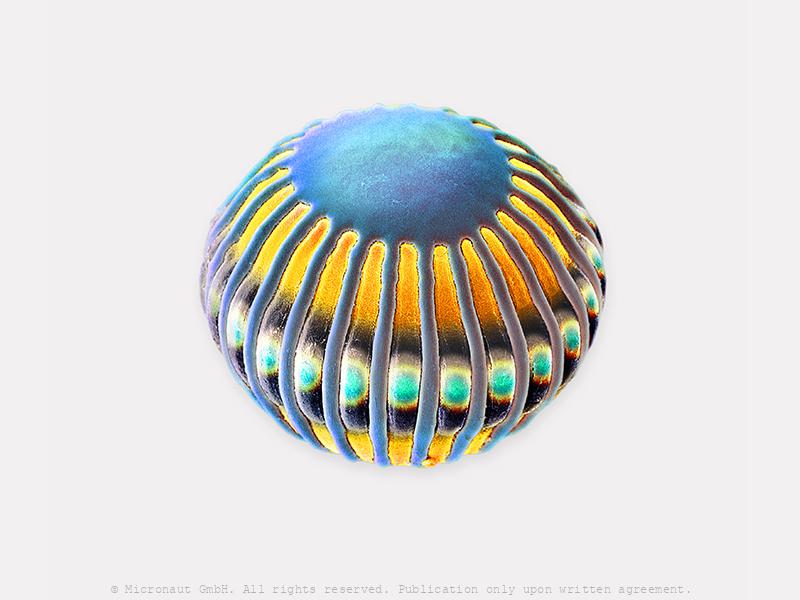
Sweet Pea Shrub Pollen (Polygala grandiflora) - I/III
This are pollen grains of the Sweet Pea Shrub (Polygala grandiflora), captured with a scanning-electron-microscope and subsequently hand-colored by science photographer Martin Oeggerli. The pollen grain of the Sweat Pea Shrub is equipped with a multitude of openings, called apertures, which are enabling the pollen tube to leave the protective jacket with only minimum distance to the pistil tissue. Oeggerli slowly breathes life into his works by selecting and masking different structures with color, layer upon layer utilizing the post-processing software on his computer. The process allows him to set focus on the mysterious structures of the invisibly small pollen grains. By Martin Oeggerli (Micronaut), supported by H Halbritter and PalDat, Dep. Botany and Biodiversity, University Vienna.
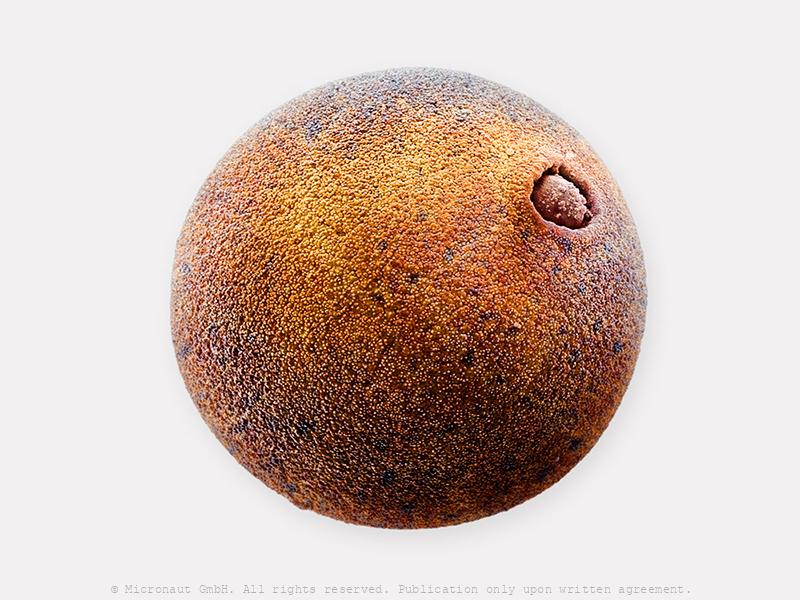
Bamboo pollen grain
Pollen is a fine to coarse powder consisting of microgametophytes (=pollen grains), which produce the male gametes (sperm cells) of seed plants. A hard coat covering the pollen grain protects the sperm cells during the process of their movement between the stamens of the flower to the pistil of the next flower. Pollen grain morphology is breathtakingly divers. By Martin Oeggerli (Micronaut), supported by H Halbritter and PalDat, Dep. Botany and Biodiversity, University Vienna.
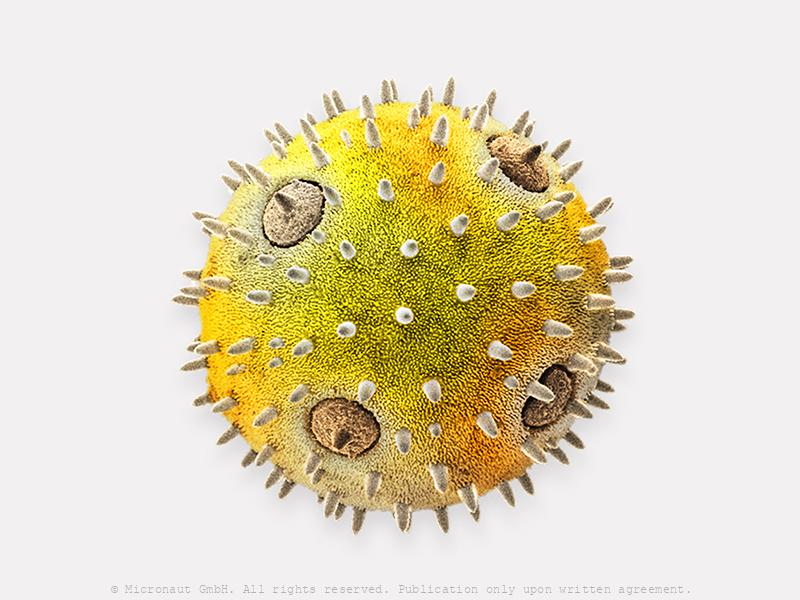
Two pollen grains of different size
Pollen is a fine to coarse powder consisting of microgametophytes (=pollen grains), which produce the male gametes (sperm cells) of seed plants. A hard coat covering the pollen grain protects the sperm cells during the process of their movement between the stamens of the flower to the pistil of the next flower. Pollen grain morphology is breathtakingly divers. By Martin Oeggerli (Micronaut), supported by H Halbritter and PalDat, Dep. Botany and Biodiversity, University Vienna.
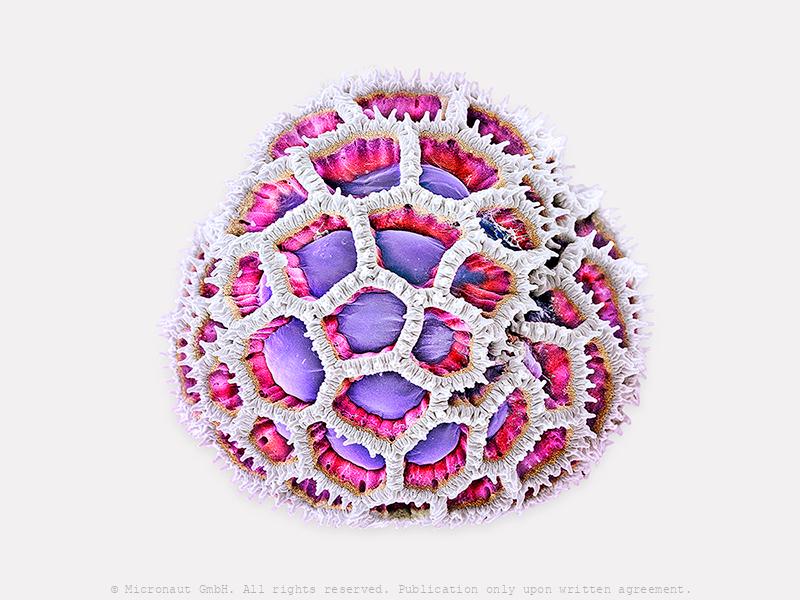
Pink thrift pollen grain (Armreif canescens)
Pink Thrift pollen grain. By Martin Oeggerli (Micronaut), supported by H Halbritter and PalDat, Dep. Botany and Biodiversity, University Vienna.
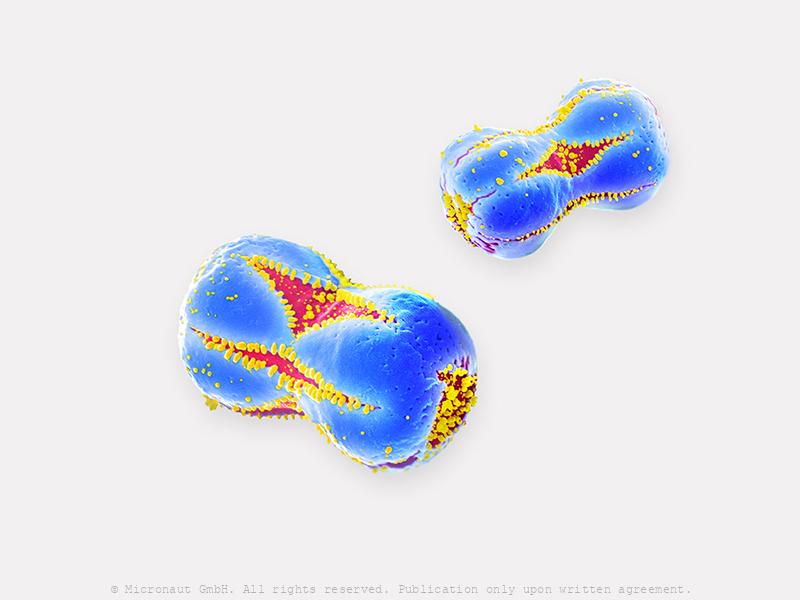
Forgetmenot pollen
Forgetmenot (Myosotis sylvatica) pollen are the smallest pollen in the universe
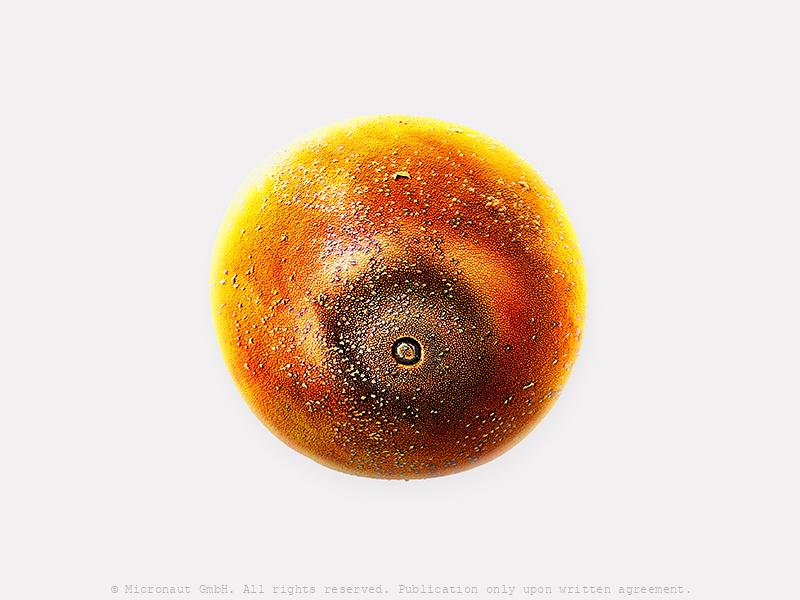
Corn Pollen (Zea mays)
Artistic coloration of a Corn (Zea mays) pollen grain. Wind pollinated Corn produces billions of pollen grains to ensure successful fertilization. In contrast to other plant species, the Corn pollen grain es equipped with just one single opening, enabling the pollen tube to leave the protective jacket. Corn produces male (tip) and female (corn combs) flowers. Corn combs grow from nodes along the tribe. Silks elongate from each ovary on the developing comb. Each primary comb may develop up to 1,000 ovules, and around 400-700 are usually harvested. Pollen that lands on a silk is captured by small hairs called trichomes. The pollen grain germinates immediately, producing a pollen tube that grows down the length of the silk, resulting in fertilization of the ovule within 12 to 28 hours. Oeggerli slowly breathes life into his works by painstakingly selecting different structures with different colors, layer upon layer on his laptop. The process allows him to set focus on the mysterious structures of this allergenic pollen.
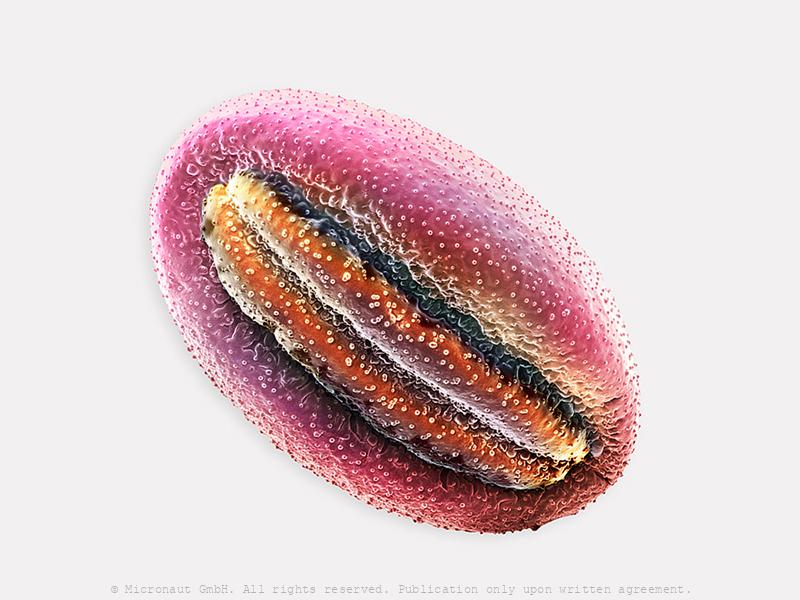
Papillana pollen grain
Pollen grain of a lily.
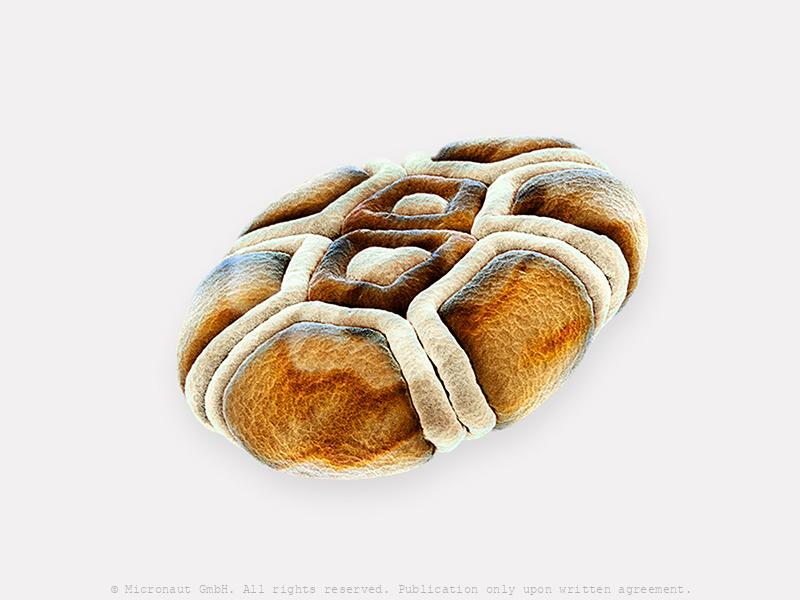
Pollen grain from an Akazia
Pollen is a fine to coarse powder consisting of microgametophytes (=pollen grains), which produce the male gametes (sperm cells) of seed plants. A hard coat covering the pollen grain protects the sperm cells during the process of their movement between the stamens of the flower to the pistil of the next flower. Pollen grain morphology is breathtakingly divers. By Martin Oeggerli (Micronaut), supported by H Halbritter and PalDat, Dep. Botany and Biodiversity, University Vienna.
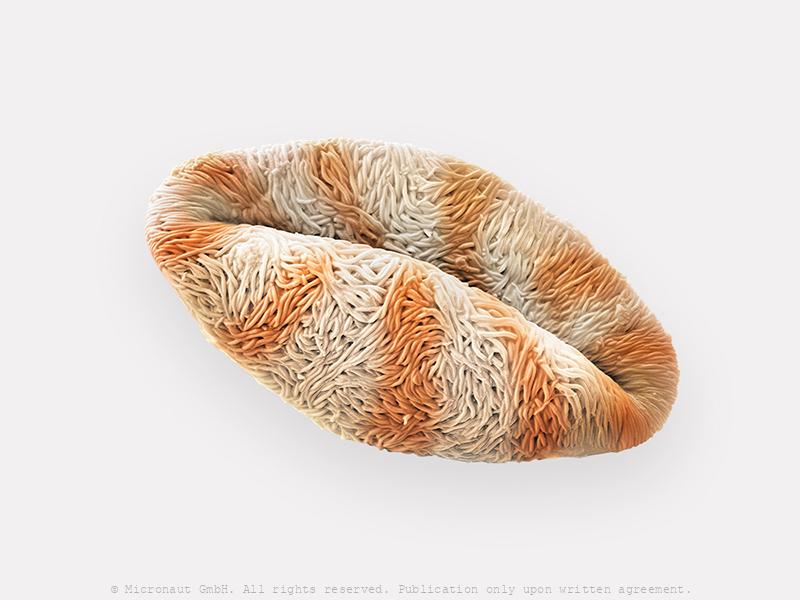
Chaenomeles pollen grain
Chaenomeles pollen grain
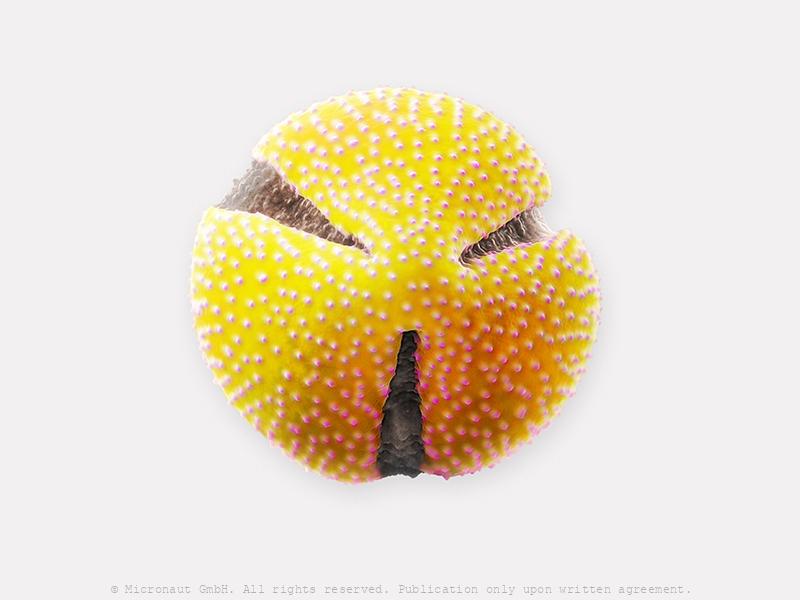
Winter aconite pollen (Eranthis hyemalis), Nr.2
This single pollen grain of a Winter aconite (Eranthis hyemalis) is loosely attached to the surface of the pistil.
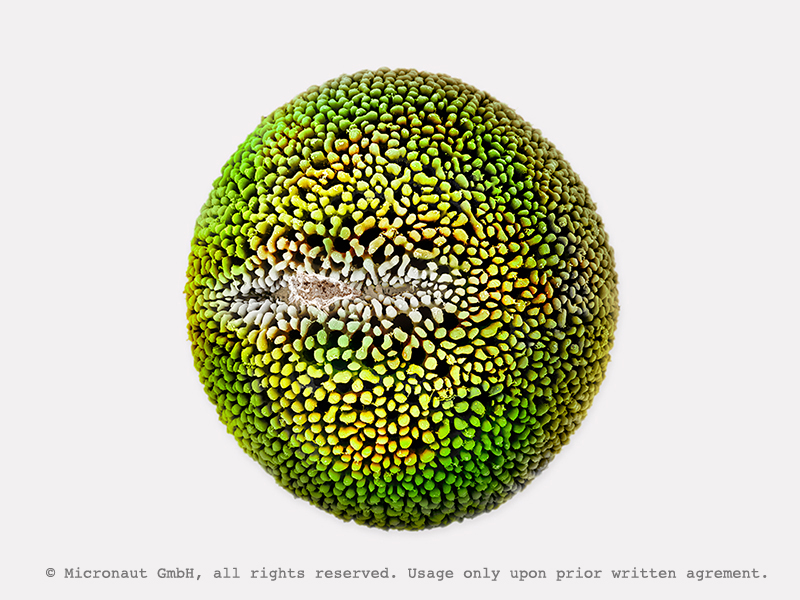
Cranebill pollen (Geranium sp., phaeum?)
Cranebill (Geranium phaeum) pollen grain. It's a spherical and very large pollen grain, featuring three apertures (i.e. pre-formed openings for exit of the pollen tube). One is visible at the center of the image (two remain hidden behind). In the general theory, pollen tube length is predetermined by provisions within the pollen grain and therefore the pistil length is a veritable test for the pollen. In the family of Cranebills, the co-evolutionary arms-race between pistil length and pollen size has finally lead to disproportionally long pistils and large size pollen grains. It makes sure the egg cells are fertilized by high quality pollen grains.
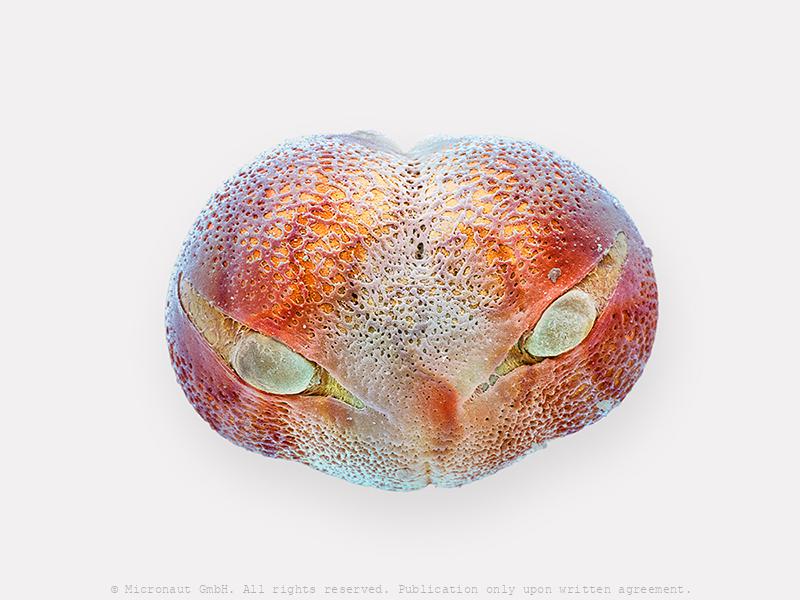
Epacris pollen grain
By Martin Oeggerli (Micronaut), supported by H Halbritter and PalDat, Dep. Botany and Biodiversity, University Vienna.
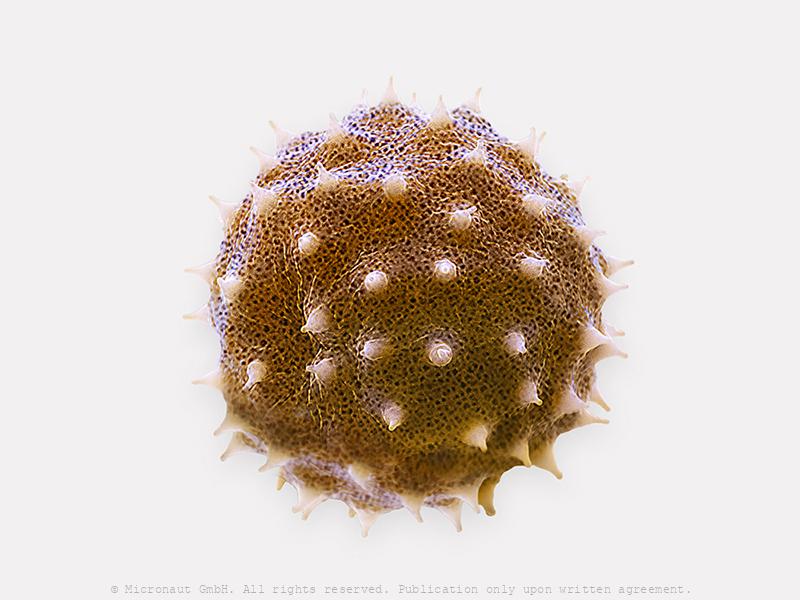
Abutilon pollen
Abutilon pollen is medium to large in size and has a spiny exine surface.
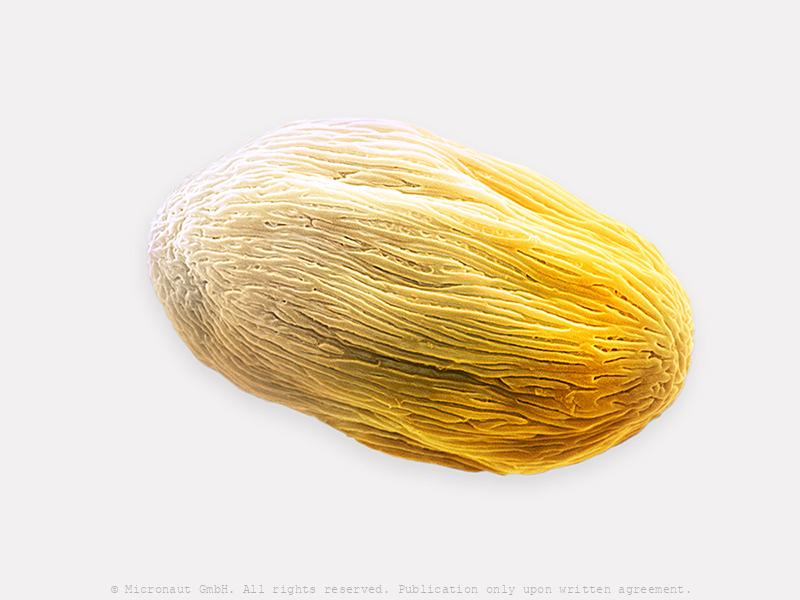
Angel's trumpet pollen
Pollen grains of the Angel's trumpet
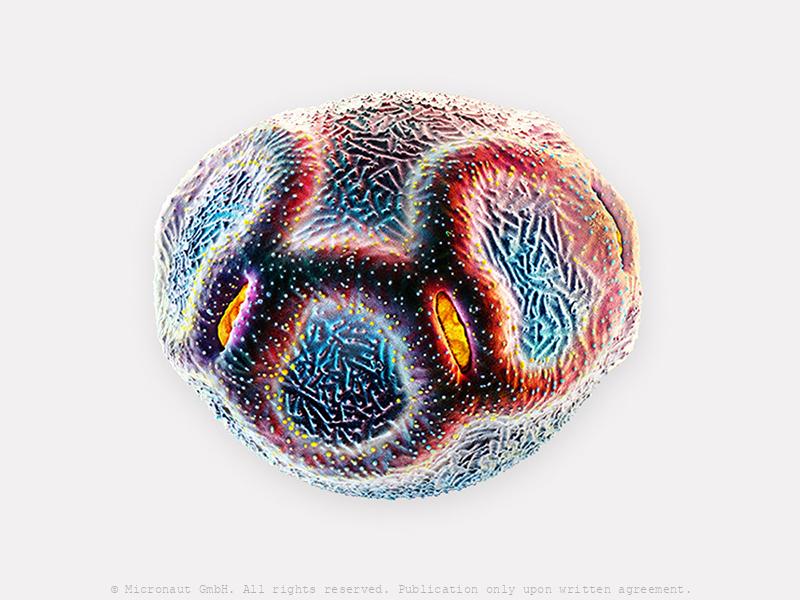
Alnus Pollen Grain - An Intimate Lottery!
Pollen is a fine to coarse powder consisting of microgametophytes (=pollen grains), which produce the male gametes (sperm cells) of seed plants. Wind pollinated plants have to make billions of pollen grains if one might succeed - it's an intimate improbably lottery! A hard coat covering the pollen grain protects the sperm cells during the process of their movement between the stamens of the flower to the pistil of the next flower. Pollen grain morphology is breathtakingly divers. Wind pollinating plants generally produce small grains with a smooth surface, thereby increasing the probability of successful fertilization. Oeggerli slowly breathes life into his works by painstakingly selecting different structures with different colors, layer upon layer on his laptop. The process allows him to set focus on the mysterious structures of this highly allergenic alder (Alnus glutinosa) pollen. To travel many 1000 kilometers, wind-pollinated Alder pollen are leight-weight constructions with a smooth and non-sticky surface, in order to be carried over large distances. By Martin Oeggerli (Micronaut), supported by Pathology, University Hosp. Basel, C-CINA, Biozentrum, University Basel, and H Halbritter and PalDat, Dep. Botany and Biodiversity, University Vienna.
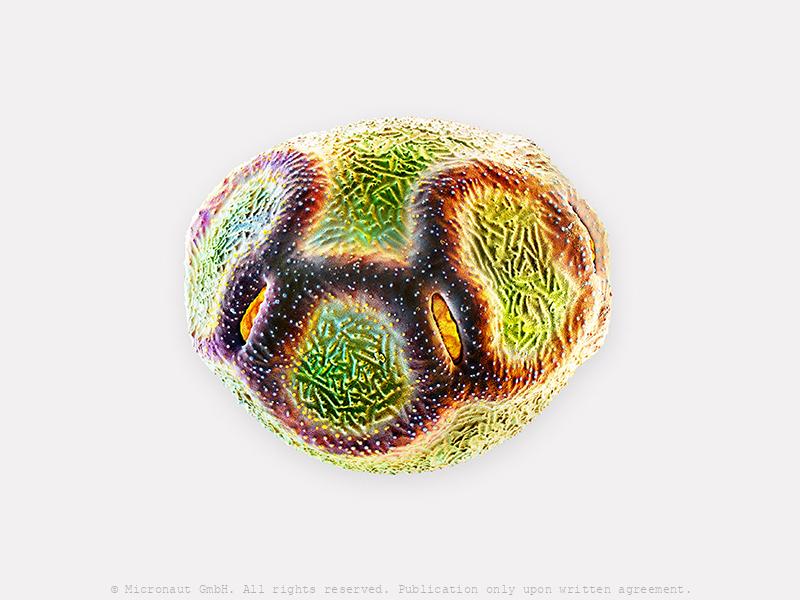
The Alnus Pollen Grain - Intimate Lottery (green version)
Pollen is a fine to coarse powder consisting of microgametophytes (=pollen grains), which produce the male gametes (sperm cells) of seed plants. Wind pollinated plants have to make billions of pollen grains if one might succeed - it's an intimate improbably lottery! A hard coat covering the pollen grain protects the sperm cells during the process of their movement between the stamens of the flower to the pistil of the next flower. Pollen grain morphology is breathtakingly divers. Wind pollinating plants generally produce small grains with a smooth surface, thereby increasing the probability of successful fertilization. Oeggerli slowly breathes life into his works by painstakingly selecting different structures with different colors, layer upon layer on his laptop. The process allows him to set focus on the mysterious structures of this highly allergenic alder (Alnus glutinosa) pollen. To travel many 1000 kilometers, wind-pollinated Alder pollen are leight-weight constructions with a smooth and non-sticky surface, in order to be carried over large distances.
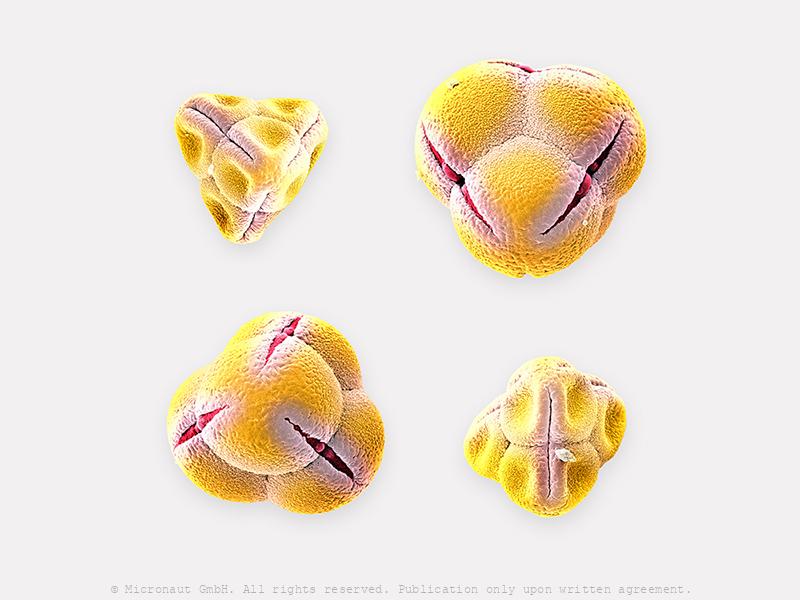
Erica pollen grains (dry and hydrated). Different orientations
By Martin Oeggerli (Micronaut), supported by H Halbritter and PalDat, Dep. Botany and Biodiversity, University Vienna.
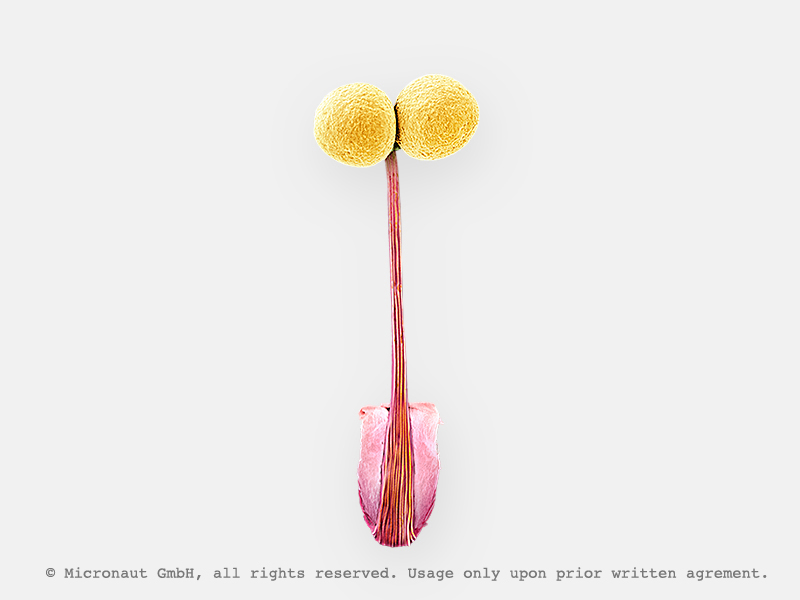
©-Micronaut-Pollen-Aerides-multiflora_9-GREYBACK copy
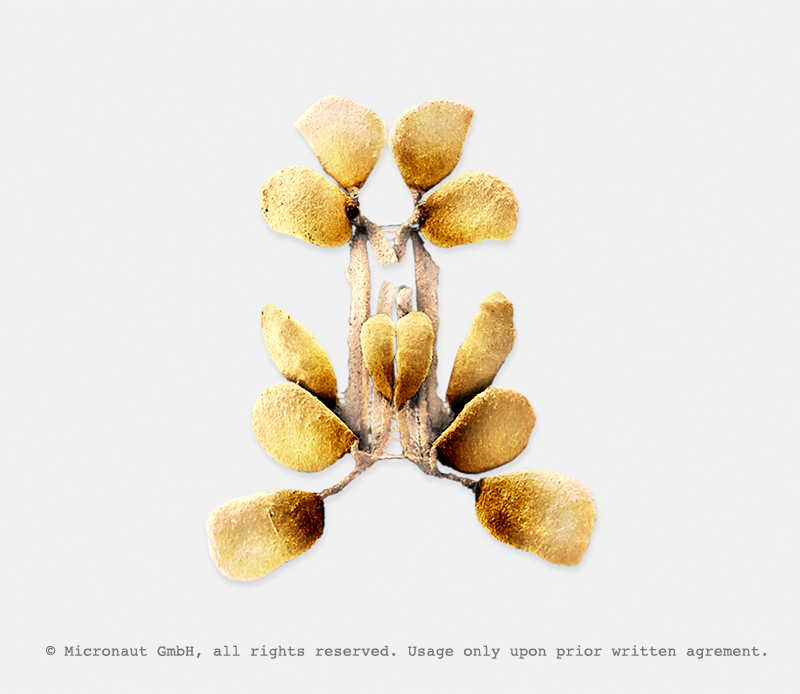
©-Micronaut-Pollen-Brassavola-cucullata_03
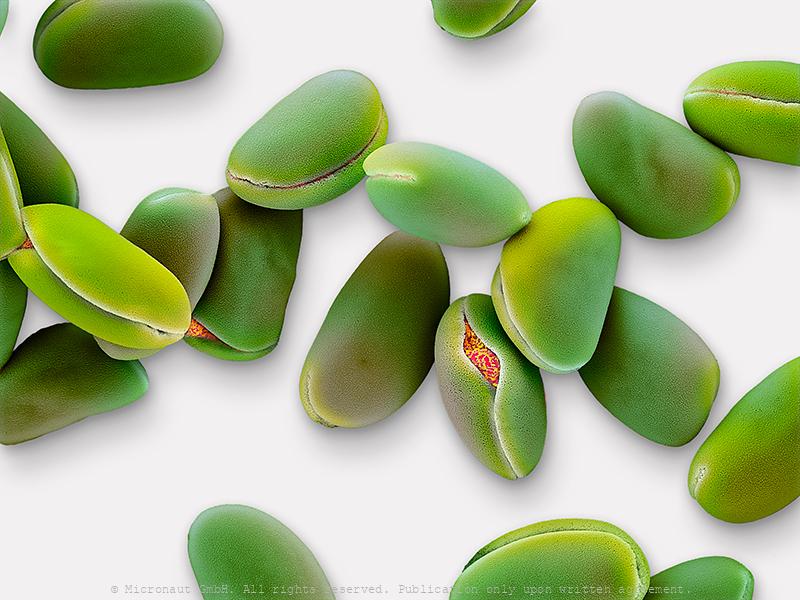
Snowdrop pollen (Galanthus nievalis)
Common snowdrop (Galanthus nievalis) is a typically wind pollinated plant. In early spring, the plant grow from bulbs –sometimes directly through snow- to open just a single flower. Pollen are oval shaped with a smooth surface.
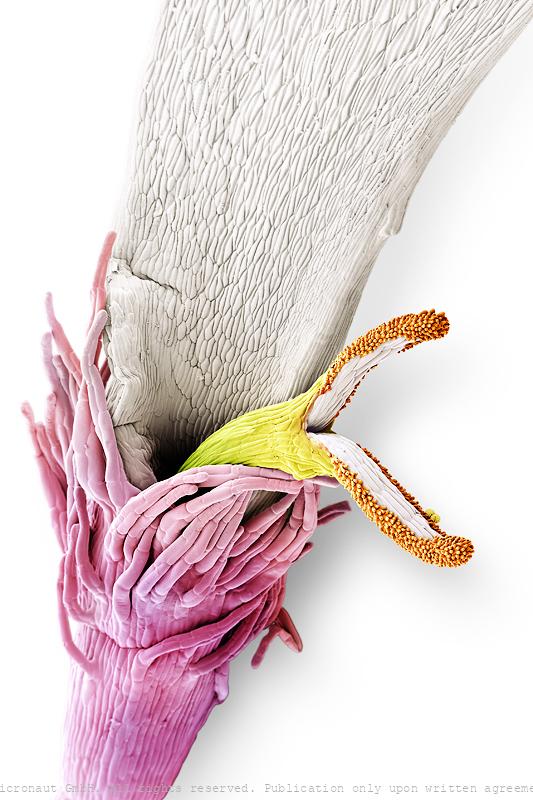
Peripheral floret from a Composite Flower (B)
Single floret from a compound flower (The Common Daisy; Bellis perennis) with two small pollen sticking to the tip of the pistil. Florets from the border of the influorescence have developped a special morphology with five long clean and seamlessly adnate white sepals, in order to attract pollinators.
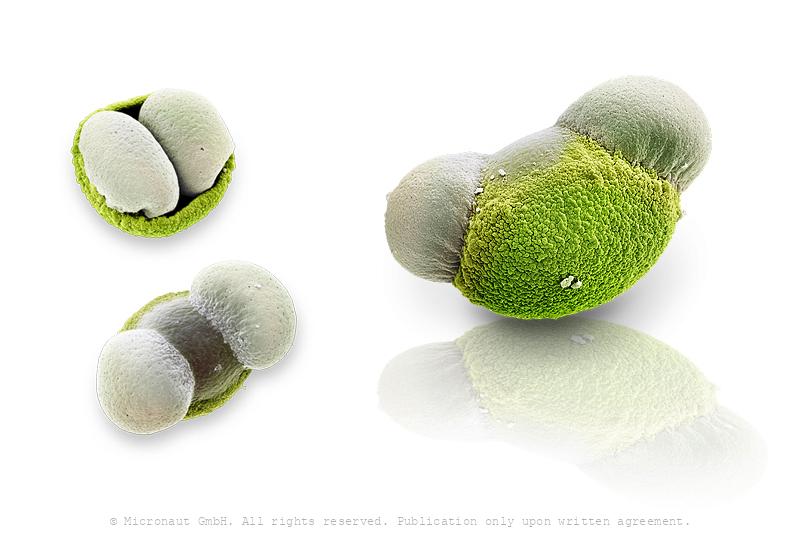
The colossal Pine pollen
Pollen grains are stunningly beautiful and remarkably diverse. The size varies from 10 to 250 µm. To be carried more easily by the wind, the pine pollen capsule is equipped with two light balloon-like envelopes. By Martin Oeggerli (Micronaut), supported by H Halbritter and PalDat, Dep. Botany and Biodiversity, University Vienna.
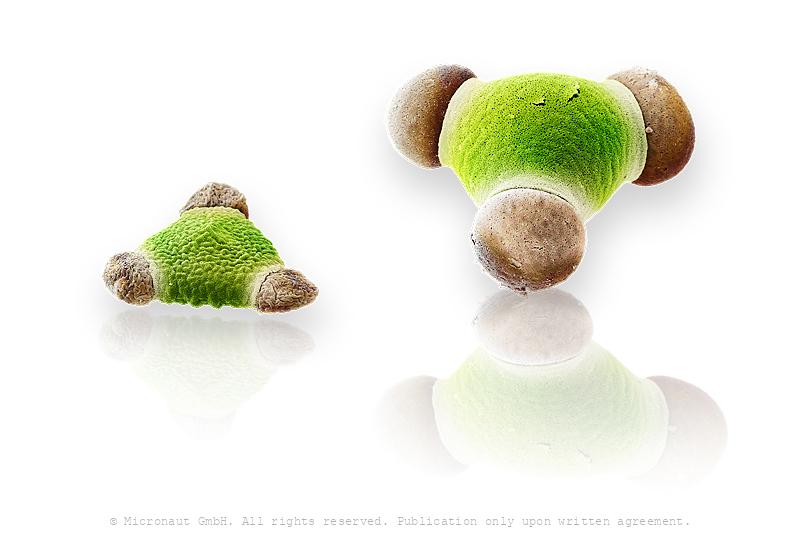
Silverleaf pollen, dry and hydrated (Banksia sp.)
Pollen grains are stunningly beautiful and remarkably diverse. The size varies from 10 to 250 µm. To be carried more easily by the wind, the pine pollen capsule is equipped with two light balloon-like envelopes. By Martin Oeggerli (Micronaut), supported by H Halbritter and PalDat, Dep. Botany and Biodiversity, University Vienna.
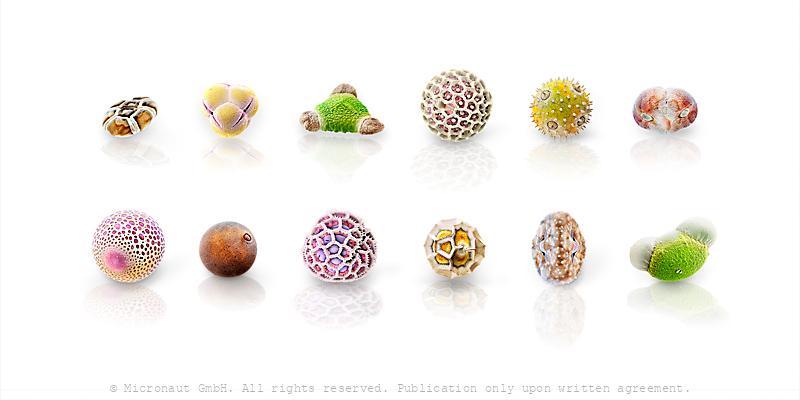
The universe of pollen
Pollen grains are remarkably diverse and vary in size from 10 to 250 µm. First illustrations of pollen grains start in the 17th century, shortly after the development of the first light microscope. At the end of the 19th century most characteristics of the capsule structure have already been established. One and a half centuries later, invention and commercialization of scanning-electron-microscopy (SEM) allow fascinating new insights into the microcosmos and re-initiate pollen research. The hand-colored SEM images of pollen that have been assembled on this picture illustrate the fascinating diversity of these small carriers of the male plant genome. Artworks by Micronaut, supported by H Halbritter and PalDat, Dep. Botany and Biodiversity, University Vienna.
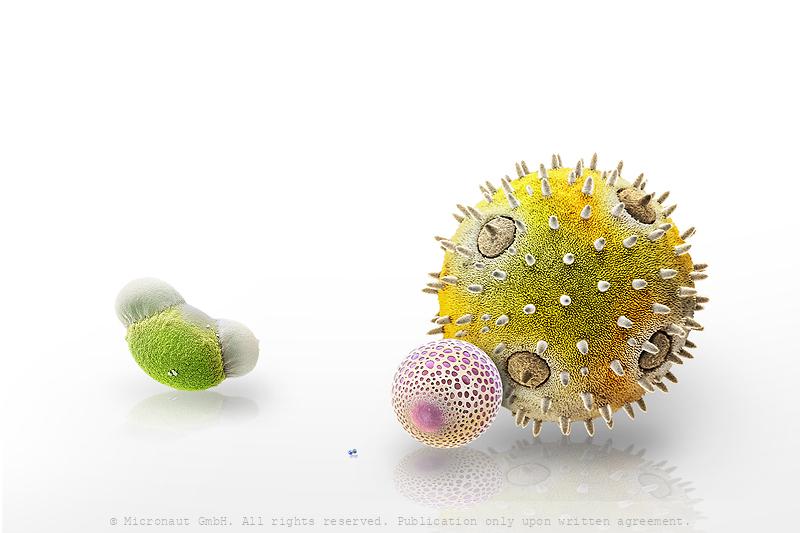
Pollen grains in comparison
Pollen grains are stunningly beautiful and remarkably diverse. The size varies from 10 to 250 µm. Here you can see a comparison of the smallest and the largest pollen worldwide. By Martin Oeggerli (Micronaut), supported by H Halbritter and PalDat, Dep. Botany and Biodiversity, University Vienna.
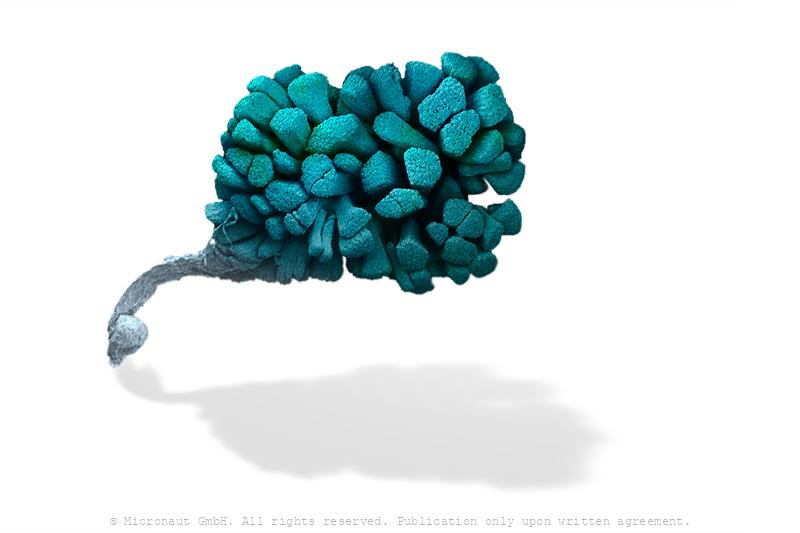
Pollinium from an Orchid
Pollen is a fine to coarse powder consisting of microgametophytes (=pollen grains), which produce the male gametes (sperm cells) of seed plants. A hard coat covering the pollen grain protects the sperm cells during the process of their movement between the stamens of the flower to the pistil of the next flower. Pollen grain morphology is breathtakingly divers. Orchids produce a pollinium, which consists of thousands of pollen grains, packed in dozens of massulae. The pollinium is attached to pollinators, which are often attracted e.g. by beautiful colors. By Martin Oeggerli (Micronaut), supported by M Svojtka, Dep. Botany and Biodiversity, University Vienna.
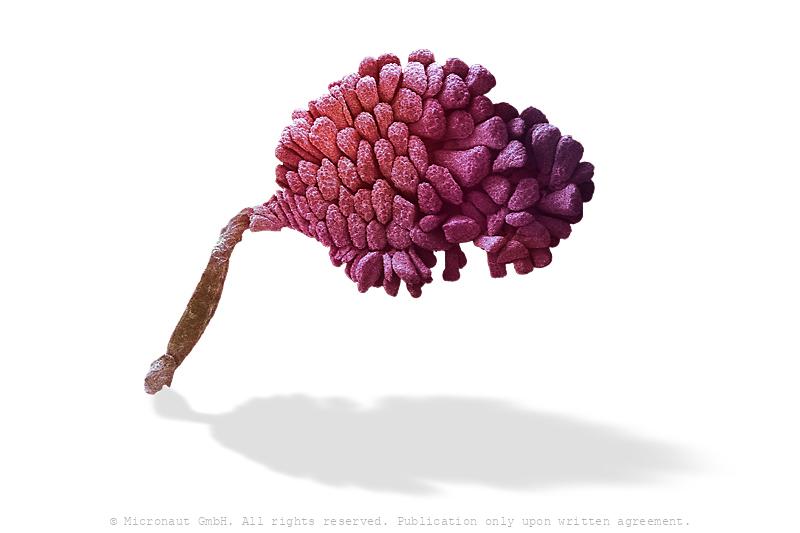
Pollinium from an Orchid
Pollen is a fine to coarse powder consisting of microgametophytes (=pollen grains), which produce the male gametes (sperm cells) of seed plants. A hard coat covering the pollen grain protects the sperm cells during the process of their movement between the stamens of the flower to the pistil of the next flower. Pollen grain morphology is breathtakingly divers. Orchids produce a pollinium, which consists of thousands of pollen grains, packed in dozens of massulae. The pollinium is attached to pollinators, which are often attracted e.g. by beautiful colors. By Martin Oeggerli (Micronaut), supported by M Svojtka, Dep. Botany and Biodiversity, University Vienna.
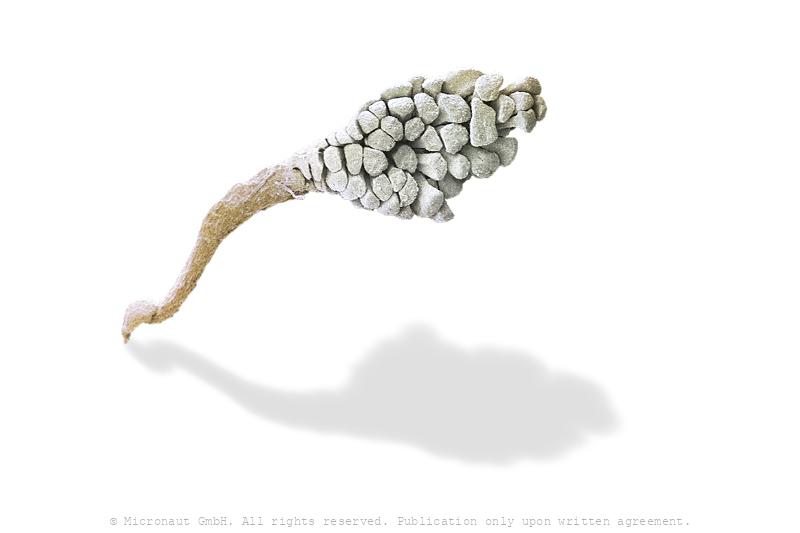
Pollinium from an Orchid
Pollen is a fine to coarse powder consisting of microgametophytes (=pollen grains), which produce the male gametes (sperm cells) of seed plants. A hard coat covering the pollen grain protects the sperm cells during the process of their movement between the stamens of the flower to the pistil of the next flower. Pollen grain morphology is breathtakingly divers. Orchids produce a pollinium, which consists of thousands of pollen grains, packed in dozens of massulae. The pollinium is attached to pollinators, which are often attracted e.g. by beautiful colors. By Martin Oeggerli (Micronaut), supported by M Svojtka, Dep. Botany and Biodiversity, University Vienna.
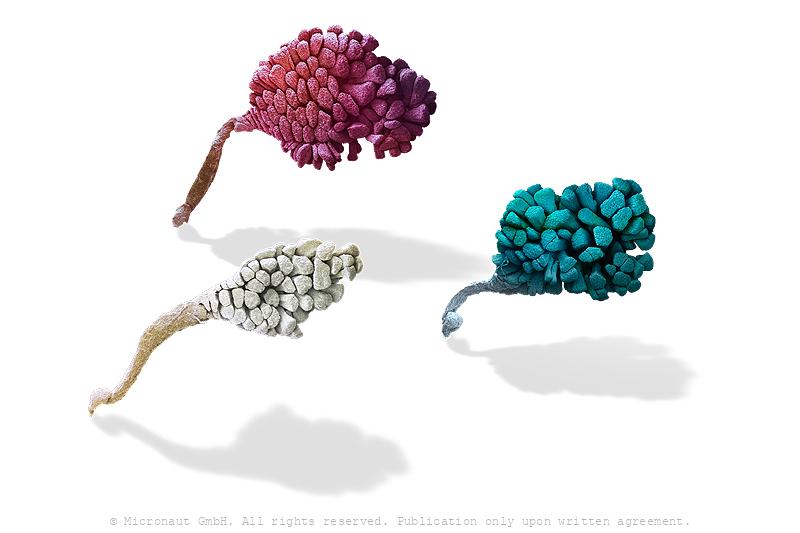
Pollinium from an Orchid
Pollen is a fine to coarse powder consisting of microgametophytes (=pollen grains), which produce the male gametes (sperm cells) of seed plants. A hard coat covering the pollen grain protects the sperm cells during the process of their movement between the stamens of the flower to the pistil of the next flower. Pollen grain morphology is breathtakingly divers. Orchids produce a pollinium, which consists of thousands of pollen grains, packed in dozens of massulae. The pollinium is attached to pollinators, which are often attracted e.g. by beautiful colors. By Martin Oeggerli (Micronaut), supported by M Svojtka and PalDat, Dep. Botany and Biodiversity, University Vienna.
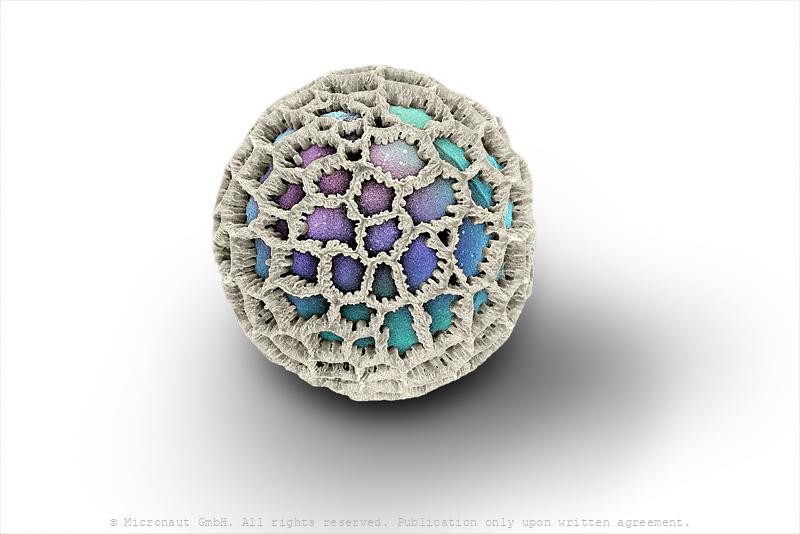
Pollen (Ruellia sp.)
Pollen is a fine to coarse powder consisting of microgametophytes (=pollen grains), which produce the male gametes (sperm cells) of seed plants. A hard coat covering the pollen grain protects the sperm cells during the process of their movement between the stamens of the flower to the pistil of the next flower. Pollen grain morphology is breathtakingly divers. By Martin Oeggerli (Micronaut), supported by H Halbritter and PalDat, Dep. Botany and Biodiversity, University Vienna.
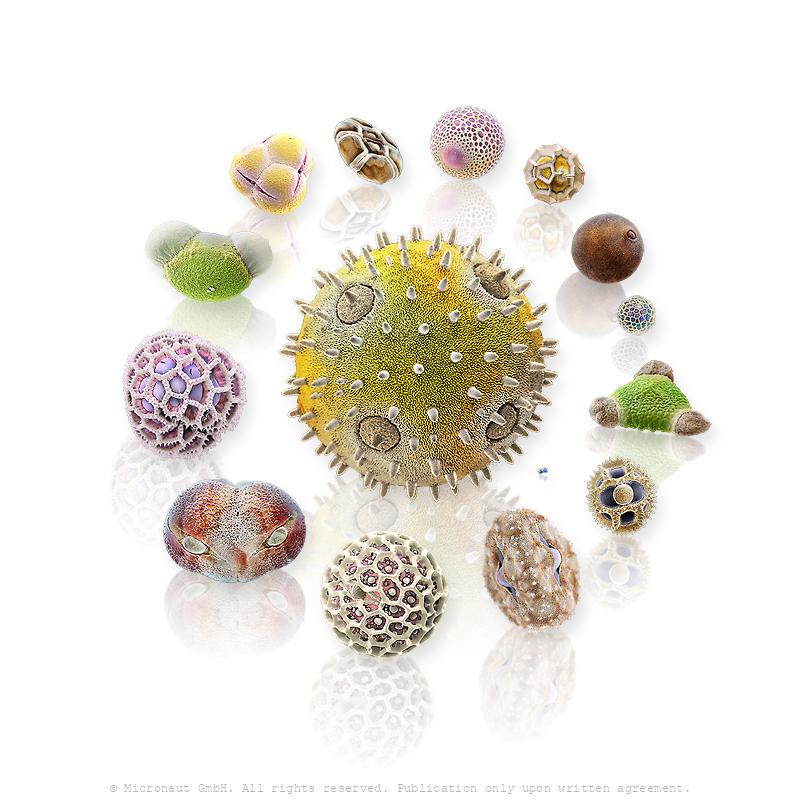
Pollen Universe
Pollen grains are remarkably diverse and vary in size from 10 to 250 µm. First illustrations of pollen grains start in the 17th century, shortly after the development of the first light microscope. At the end of the 19th century most characteristics of the capsule structure have already been established. One and a half centuries later, invention and commercialization of scanning-electron-microscopy (SEM) allow fascinating new insights into the microcosmos and re-initiate pollen research. The hand-colored SEM images of pollen that have been assembled on this picture illustrate the fascinating diversity of these small carriers of the male plant genome. Artworks by Micronaut, supported by H Halbritter and PalDat, Dep. Botany and Biodiversity, University Vienna.
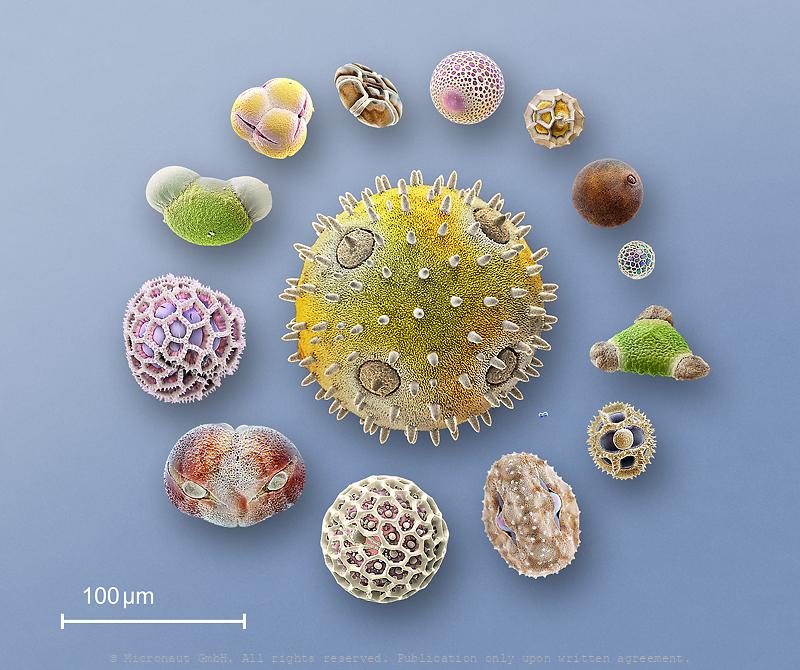
Pollen Universe
Pollen grains are remarkably diverse and vary in size from 10 to 250 µm. First illustrations of pollen grains start in the 17th century, shortly after the development of the first light microscope. At the end of the 19th century most characteristics of the capsule structure have already been established. One and a half centuries later, invention and commercialization of scanning-electron-microscopy (SEM) allow fascinating new insights into the microcosmos and re-initiate pollen research. The hand-colored SEM images of pollen that have been assembled on this picture illustrate the fascinating diversity of these small carriers of the male plant genome. Artwork by Micronaut, supported by H Halbritter and PalDat, Dep. Botany and Biodiversity, University Vienna.
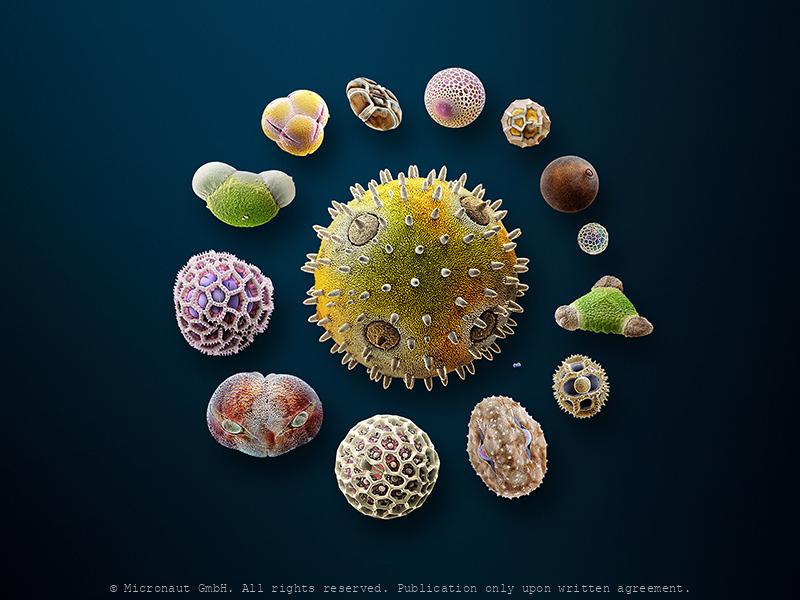
Pollen Universe
Pollen grains are remarkably diverse and vary in size from 10 to 250 µm. First illustrations of pollen grains start in the 17th century, shortly after the development of the first light microscope. At the end of the 19th century most characteristics of the capsule structure have already been established. One and a half centuries later, invention and commercialization of scanning-electron-microscopy (SEM) allow fascinating new insights into the microcosmos and re-initiate pollen research. The hand-colored SEM images of pollen that have been assembled on this picture illustrate the fascinating diversity of these small carriers of the male plant genome. Artwork by Micronaut, supported by H Halbritter and PalDat, Dep. Botany and Biodiversity, University Vienna.
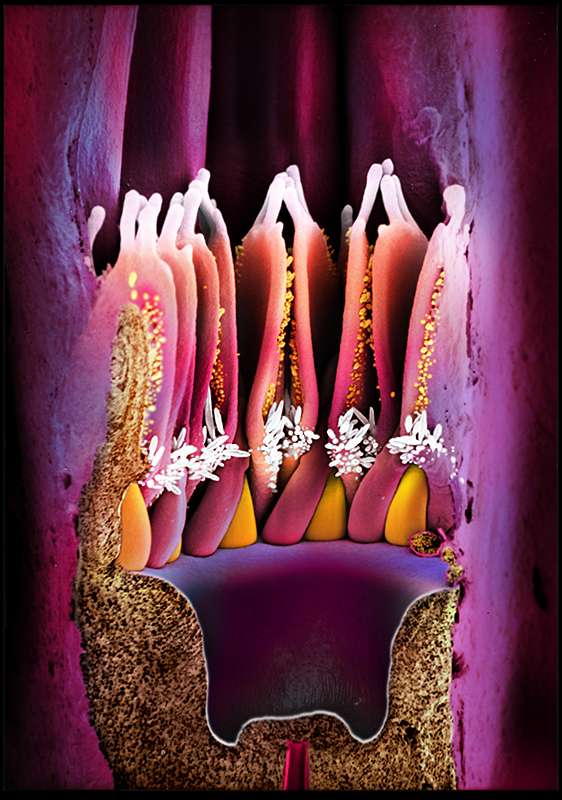
Floral Elements (Bruguiera gymnorhiza) - Nr.1
The species is Bruguiera gymnorhiza produces red pendulous flowers which attract birds (hence, bird pollination). This picture shows a longitudinal section through a young flower: at the very bottom you can see the "basal wing" of a young petal that guides a young stamen inside the petal. Next the curved stamen will elongate upwards. Reference page: http://iriomote.image.coocan.jp/research/mangrove/Bruguiera/BruguieraEnglish.html
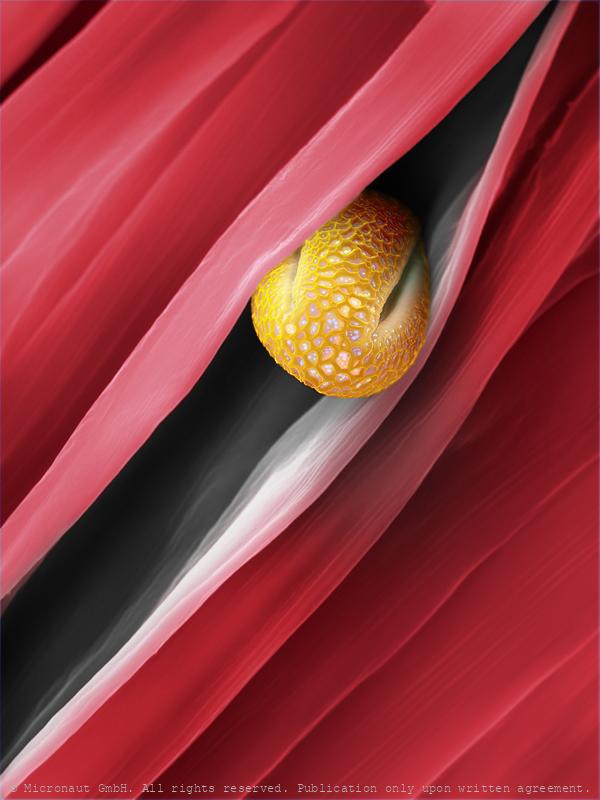
Love is in the air (Salix caprea)
A classy willow (Salix caprea) pollen, as it freshly emerges from the anther.
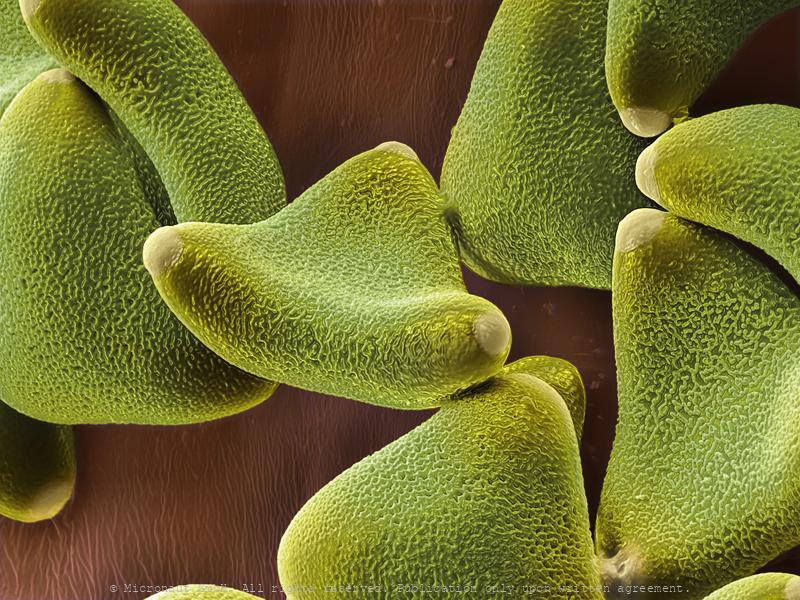
Silverlearf pollen (Banksia sp.)
Pollen grains are remarkably diverse and vary in size from 10 to 250 µm. Silverleaf tree pollen grains possess a smooth surface structure and simply rely on their sticky fluid, called pollenkit to be safely attached to pollinators. The triangular shape is typical for the family. Tips feature thin parts, called apertures, that function like preformed openings, allowing for the growth of the pollen tube.
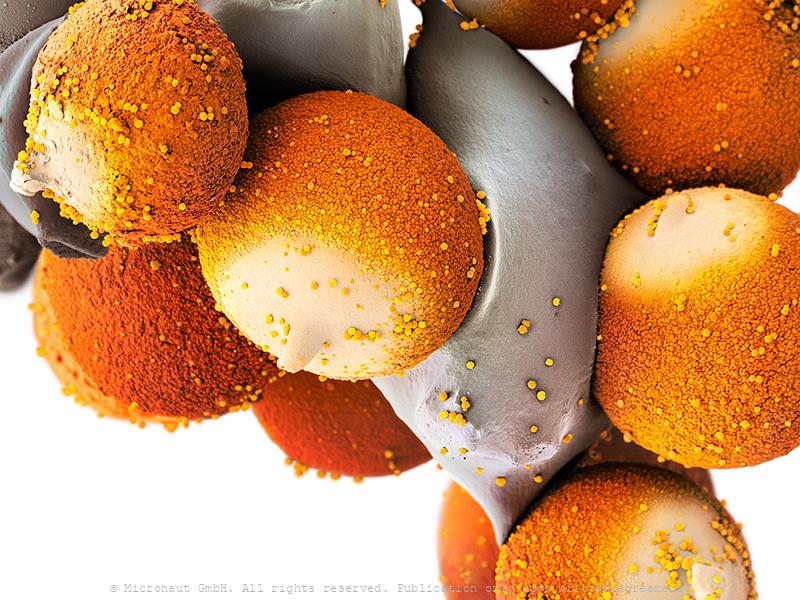
Pollen (Cryptomeria japonica), Nr.1
Pollen grains with Ubisch bodies (yellow dots). The pollen grains belong to the Japanese Cedar (Cryptomeria japonica). They are highly allergic and go through major structural chenge when exposed to nasal discharge, exposing allergens from inside the pollen grain and from the Ubisch bodies. Pollen mit Ubisch Körperchen einer Sicheltanne (trotz Namen ein Laubbaum; C. japonica). Sowohl die Ubisch Körperchen als auch das gesamte Pollenkorn beeinhalten stark allergene Substanzen.
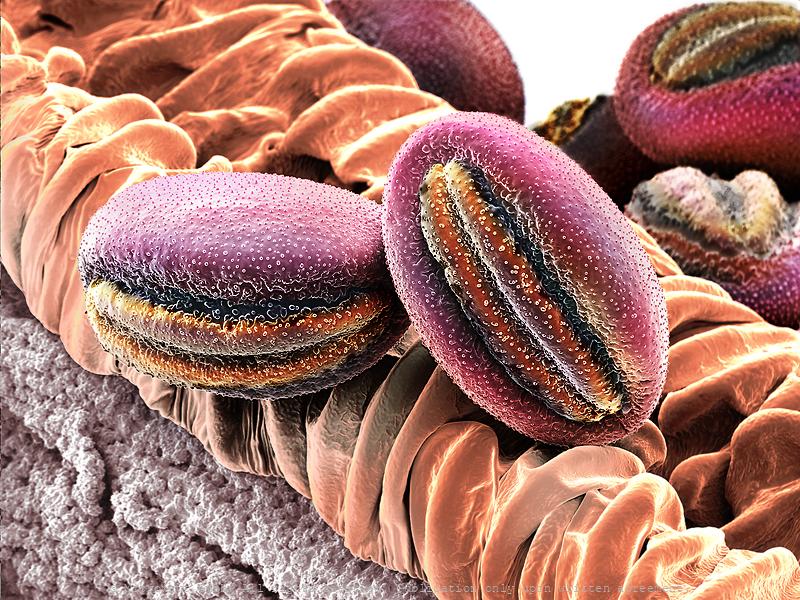
Pollen (Babiana sp.)
These pollen grains are relatively large, measuring 73µm in diameter across. It belongs to a family of of lilies, which are originally derived from South Africa, and they are pollinated by sunbirds in this case.
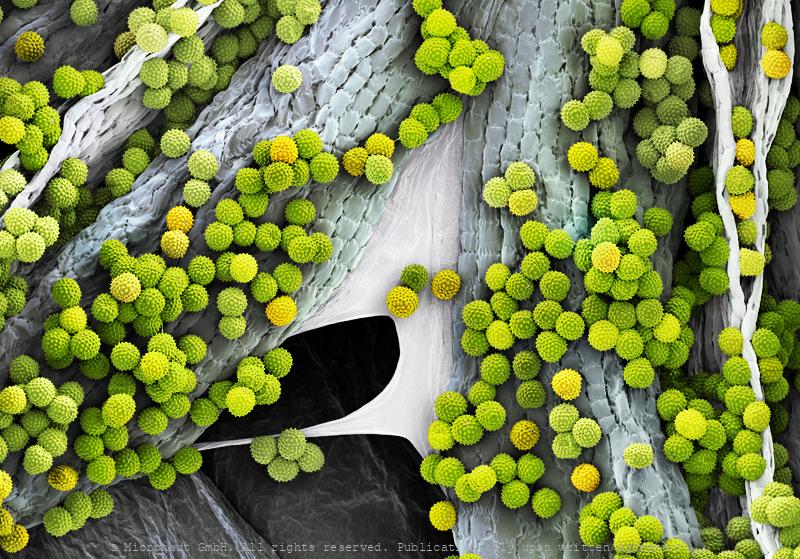
Ragweed pollen (Ambrosia artemisiifolia)
Ragweed, a rather unremarkable plant holds a stupefying record: it produces 1.6 million highly allergic pollen per hour, thereby knocking-out hayfever sufferers all around the world...
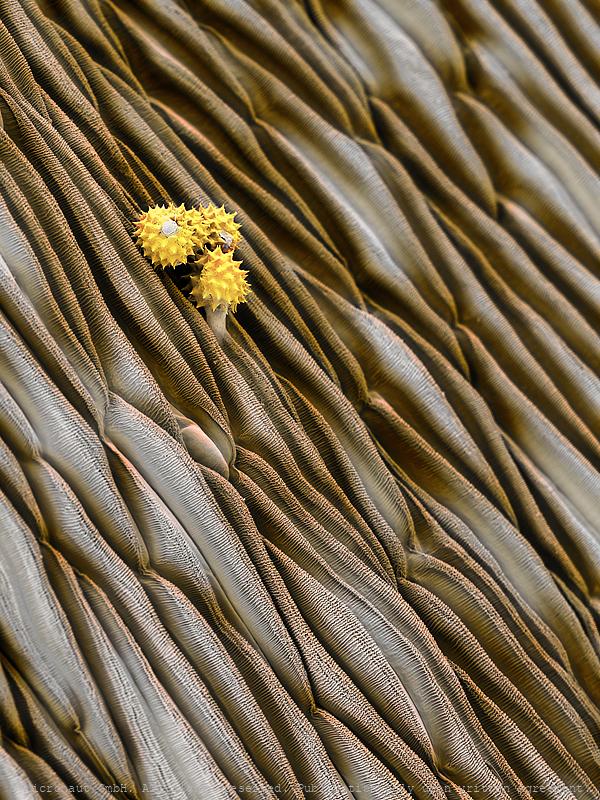
Aster pollen grains
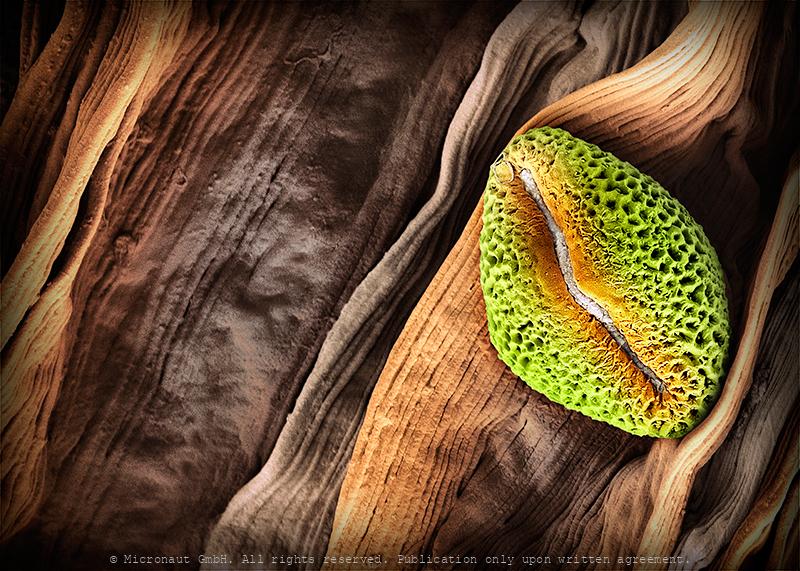
Pollen (Tulipa sp.)
A single pollen grain of a Tulip (Tulipa sp.) has attached to the pistil and starts to germinate. Eventually, the pollen tube will grow out of the cleft (=aperture), and turn to grow straight into the female reproductive tissue, to grow towards the ovules.
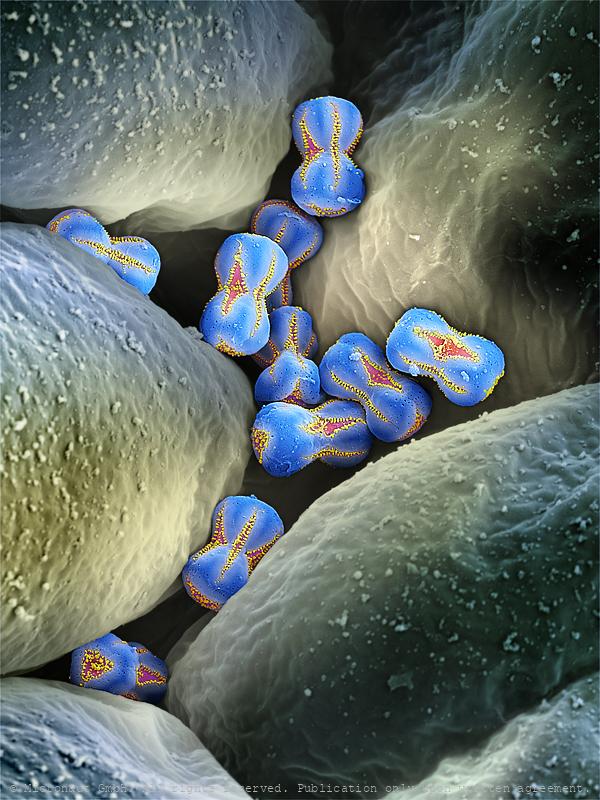
Forget me not pollen (Myosotis sylvatica), Nr.4
Forgetmenot pollen (Myosotis sylvatica) on anther. They are the smallest pollen grains worldwide, measuring only a little more than an E. coli bacterium.
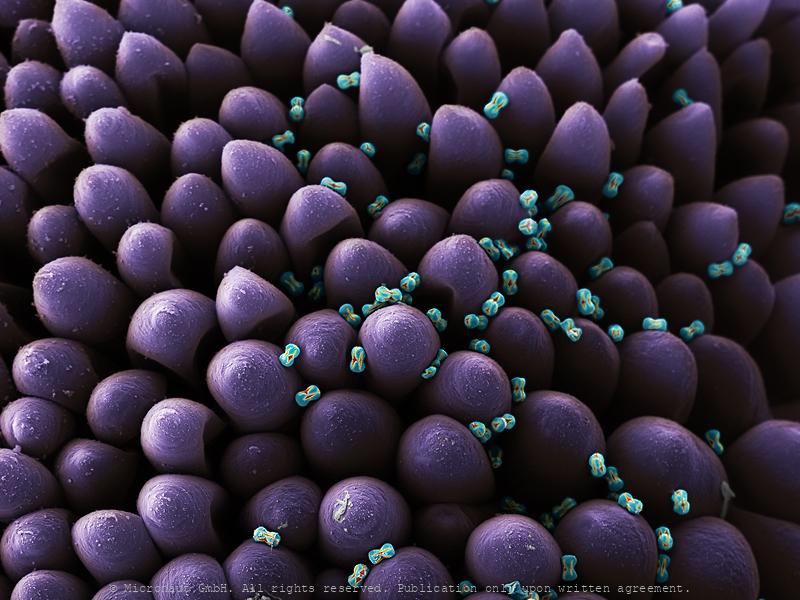
Forget me not pollen (Myosotis sylvatica), Nr.1
This image shows Forget-me-not (Myosotis sylvatica) pollen grains emerging from the anther. They are the smallest pollen grains worldwide, measuring only a little more than an E. coli bacterium.
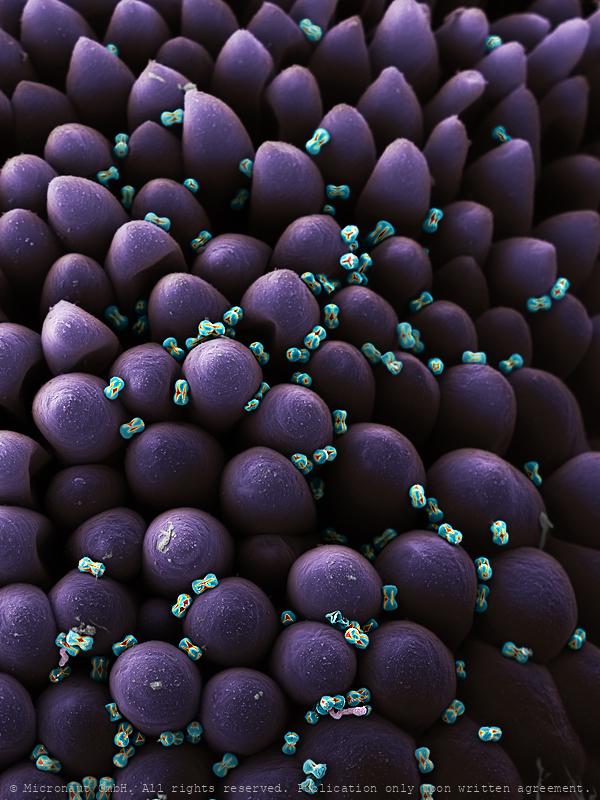
Forget me not pollen (Myosotis sylvatica), Nr.1
This image shows Forget-me-not (Myosotis sylvatica) pollen grains emerging from the anther. They are the smallest pollen grains worldwide, measuring only a little more than an E. coli bacterium.
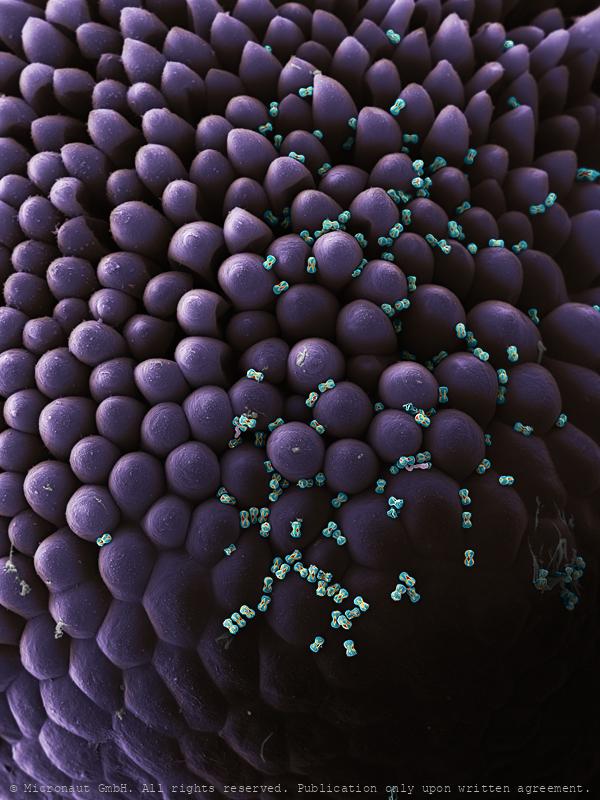
Forget me not pollen (Myosotis sylvatica), Nr.1
This image shows Forget-me-not (Myosotis sylvatica) pollen grains emerging from the anther. They are the smallest pollen grains worldwide, measuring only a little more than an E. coli bacterium.
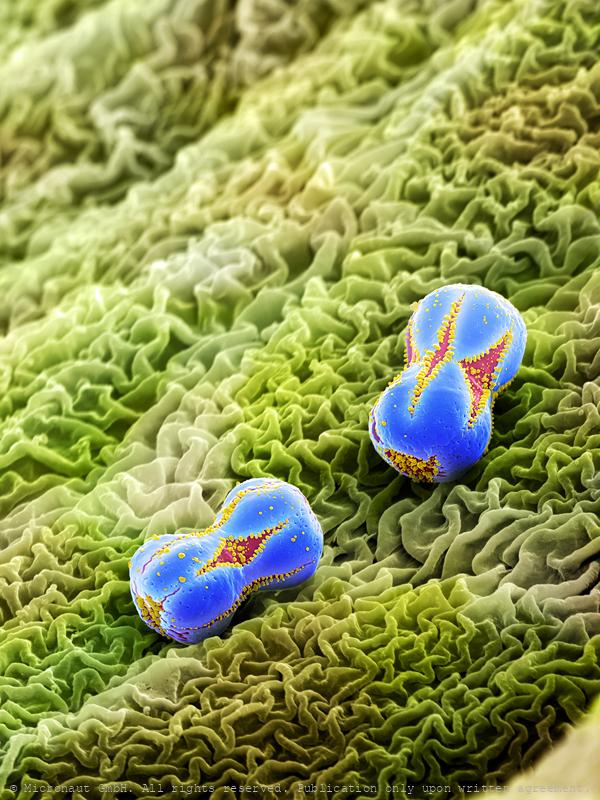
Forget me not pollen (Myosotis sylvatica), Nr.3
Forgetmenot pollen (Myosotis sylvatica) on anther. They are the smallest pollen grains worldwide, measuring only a little more than an E. coli bacterium. This image shows Forget-me-not (Myosotis sylvatica) pollen grains sticking to a sepal of the plant.
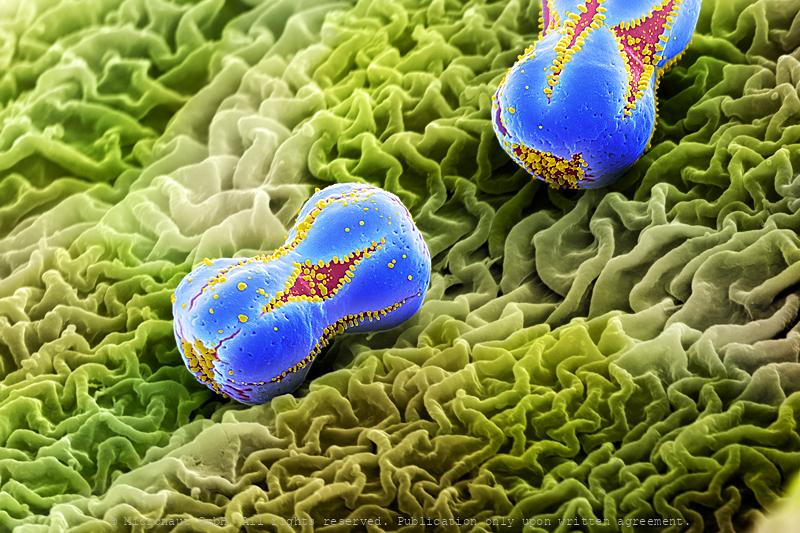
Forget me not pollen (Myosotis sylvatica), Nr.3
Forgetmenot pollen (Myosotis sylvatica) on anther. They are the smallest pollen grains worldwide, measuring only a little more than an E. coli bacterium.
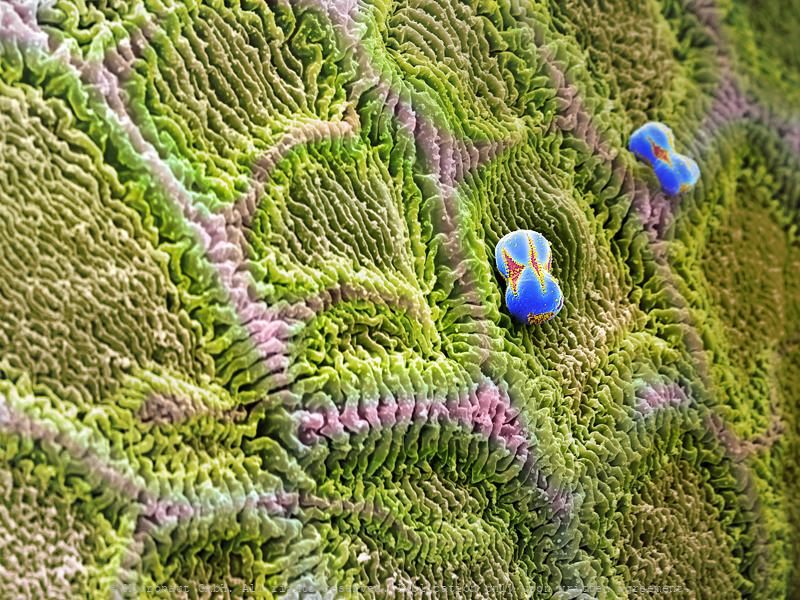
Forget me not pollen (Myosotis sylvatica), Nr.2
Forgetmenot pollen (Myosotis sylvatica) on anther. They are the smallest pollen grains worldwide, measuring only a little more than an E. coli bacterium. This image shows Forget-me-not (Myosotis sylvatica) pollen grains sticking to a sepal of the plant.
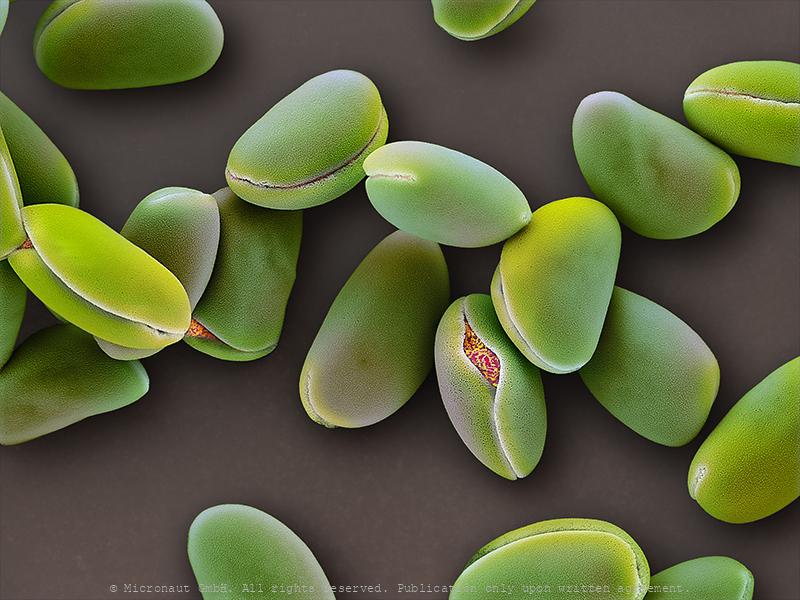
Snowdrop pollen (Galanthus nievalis)
Common snowdrop (Galanthus nievalis) is a typically wind pollinated plant. In early spring, the plant grow from bulbs –sometimes directly through snow- to open just a single flower. Pollen are oval shaped with a smooth surface.
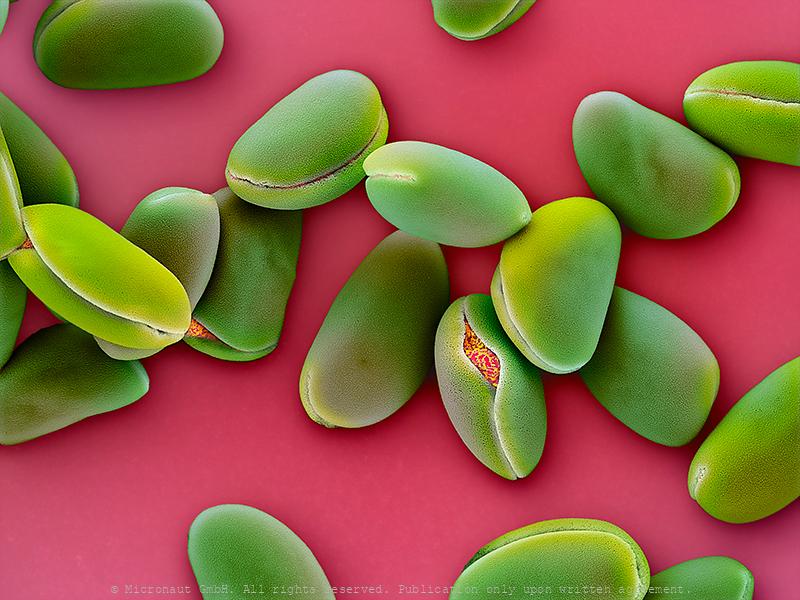
Snowdrop pollen (Galanthus nievalis)
Common snowdrop (Galanthus nievalis) is a typically wind pollinated plant. In early spring, the plant grow from bulbs –sometimes directly through snow- to open just a single flower. Pollen are oval shaped with a smooth surface.
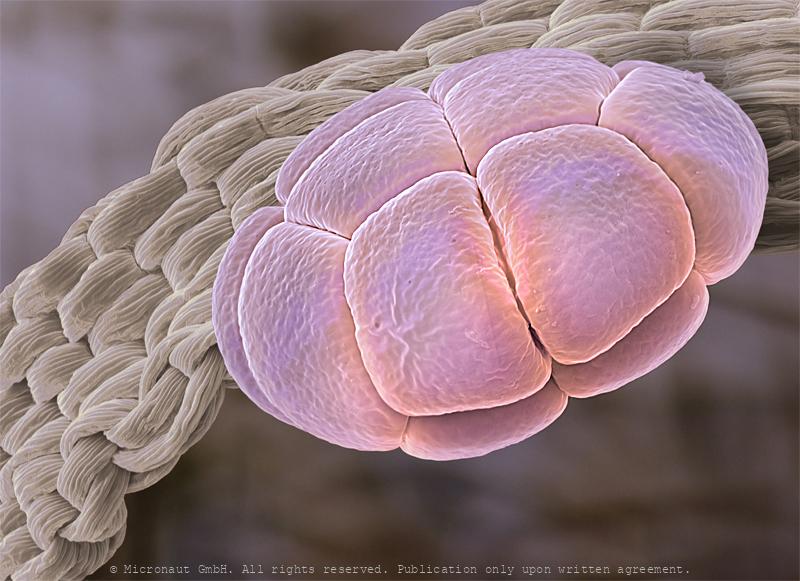
Pollen (Albizia julibrissin)
While the conventional pollen is a perfect whole, no suitable term exists for this unusually shaped pollen grain. The Persian Silk Tree and its relatives from the Acacia- family have evolved complex pollen made of many different parts. The image shows a pollen sticking to an anther. Mimosa (Albizia julibrissin) has been used for many years in Chinese Medicine to treat anxiety and depression, and its Chinese name He Huan Pi (Hua) translates to "collective happiness flower".
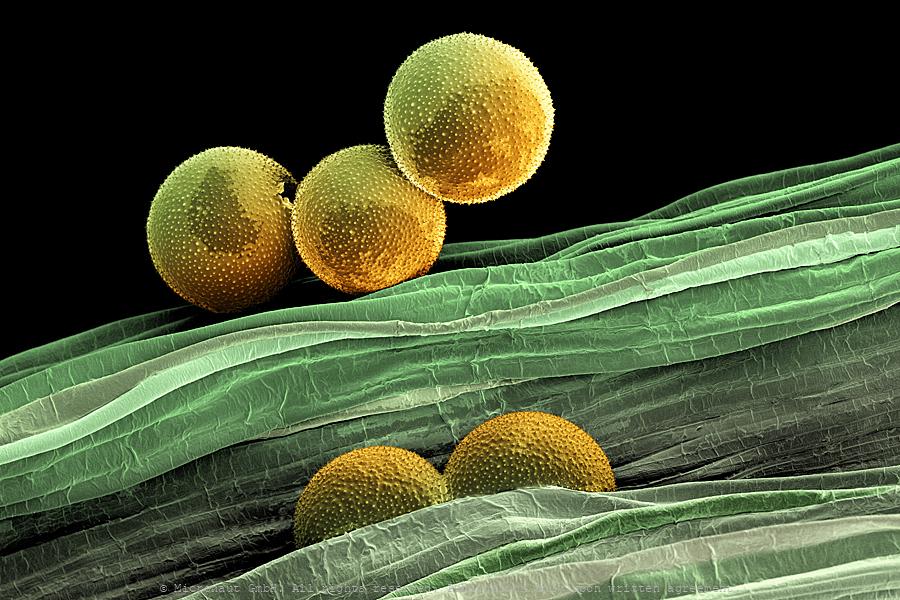
Pollen (Crocus vernus)
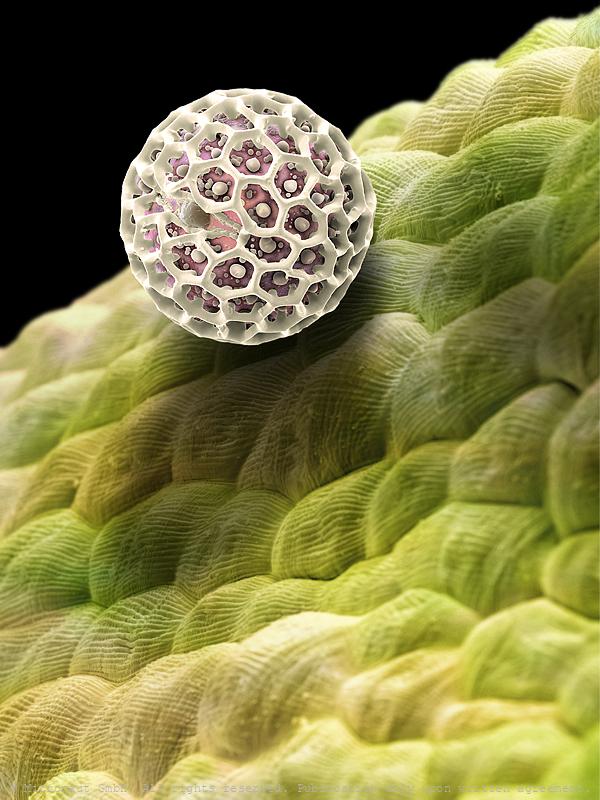
Pollen (Eranthemum sp.) on a leaf
By Martin Oeggerli (Micronaut), supported by H Halbritter and PalDat, Dep. Botany and Biodiversity, University Vienna.
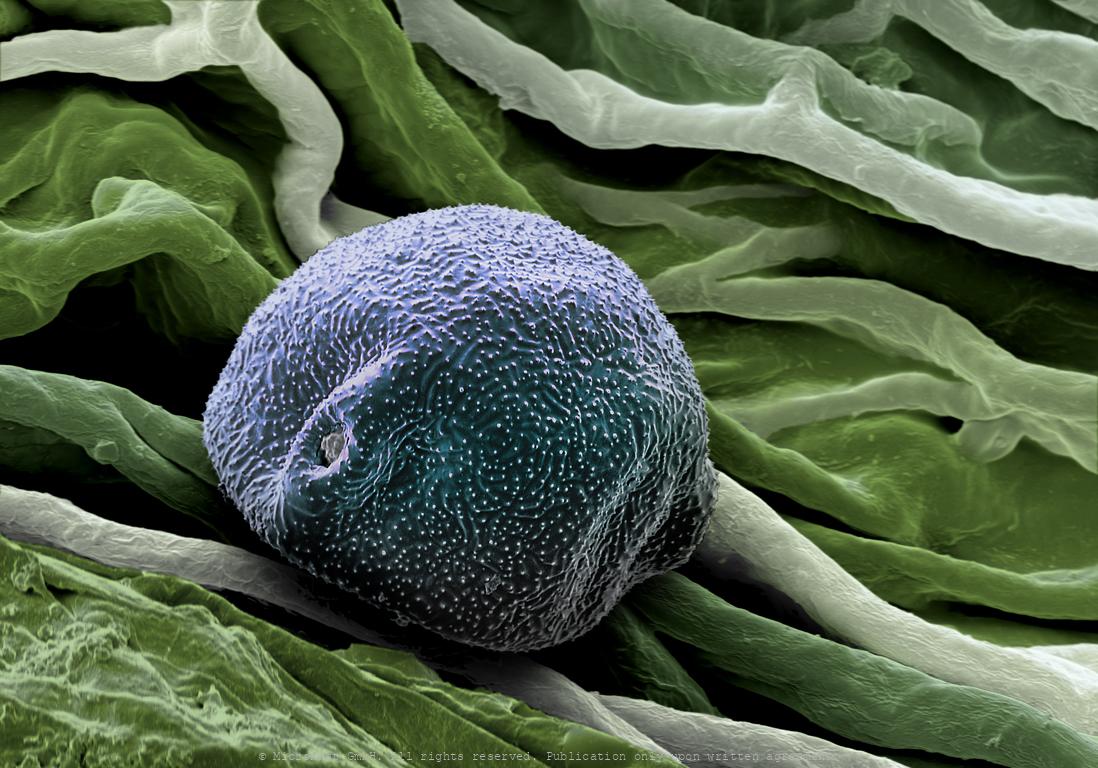
Birch pollen (Betula sp.)
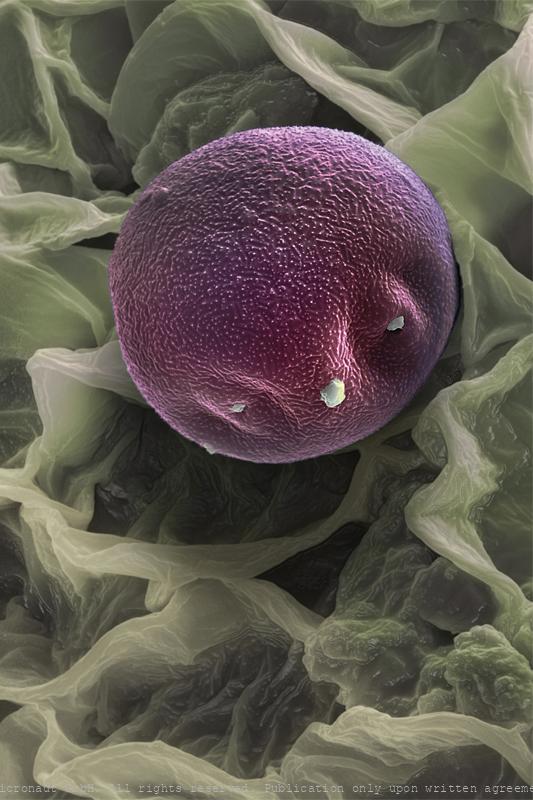
Alder pollen (Alnus sp.)
The pollen grains of alders (Alnus sp.) are highly allergic and transported by the wind. To travel many 1000 kilometers, they are leight-weight constructions with a smooth and non-sticky surface, in order to be carried by the wind more efficiently.
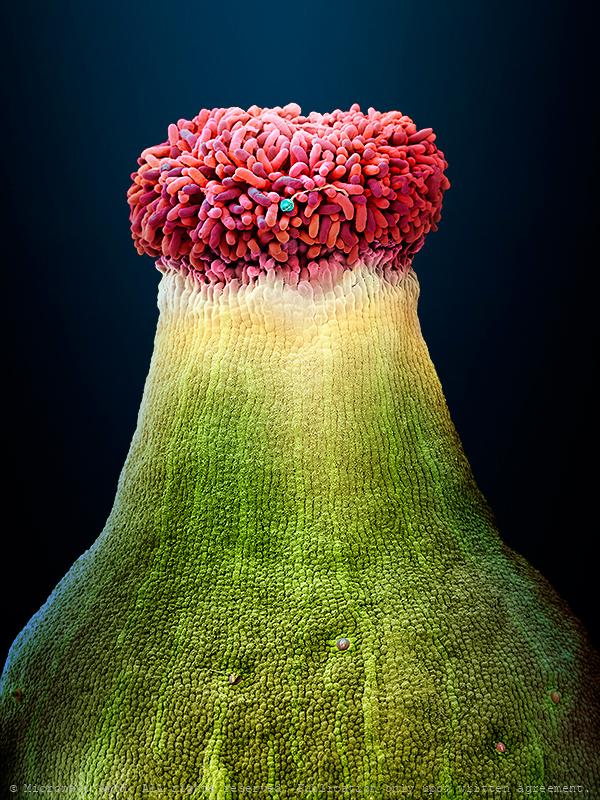
Erotic Adventures of the little Chardonnay pollen (Vitis sp.)
Pistil of a Chardonnay flower, including a pollen grain -placed in the central part of the stigma- that is growing a pollen tube. Chardonnay is a green-skinned grape variety used in the production of white wine. The variety originated in the Burgundy wine region of eastern France, but is now growing wherever wine is produced, from England to New Zealand. The Chardonnay grape itself is very neutral, with many of the flavors commonly associated with the grape being derived from such influences as terroir and oak. Chardonnay is also an important component of many sparkling wines, including Champagne. Modern DNA fingerprinting research suggests that Chardonnay is the result of a cross between the Pinot noir and Gouais blanc. The Romans are thought to have brought Gouais blanc from Croatia, and it was widely cultivated by peasants in eastern France. The Pinot of the French aristocracy grew in close proximity to the Gouais blanc, giving both grapes ample opportunity to interbreed.
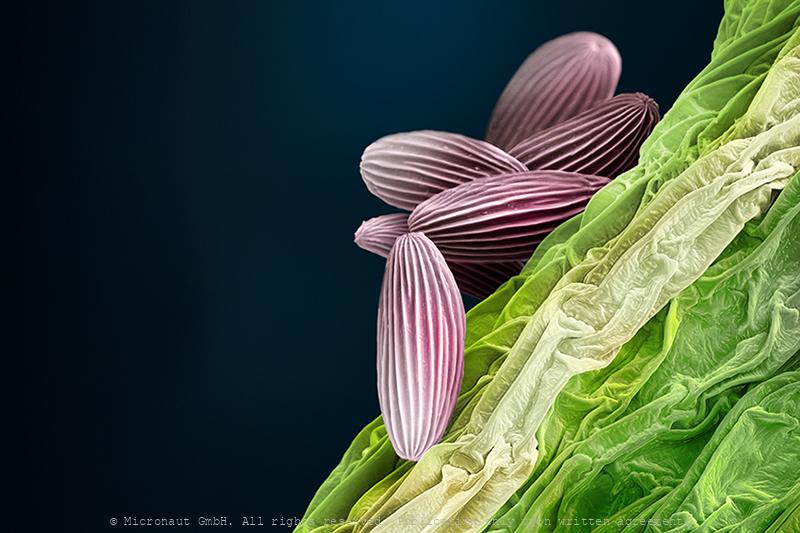
Water cabbage pollen (Pistia sp.)
Water cabbage (Pistia sp.) is an invasive plant and was first described from Nile close to lake Victoria. Despite a tiny flower, the pollen is a medium sized elliptic monad covered with equatorial crests, which are rarely found features in the pollen universe.
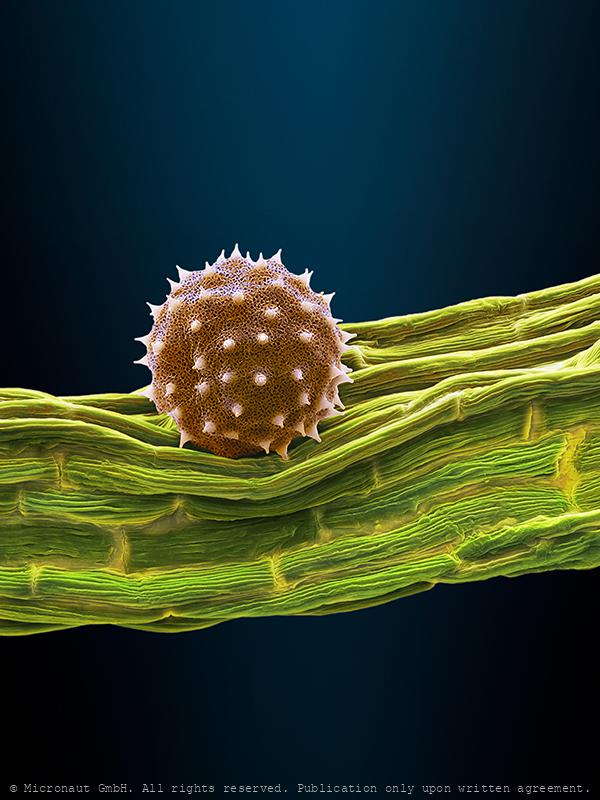
Pollen (Abutilon sp.)
Abutilon pollen is medium to large in size and has a spiny exine surface.
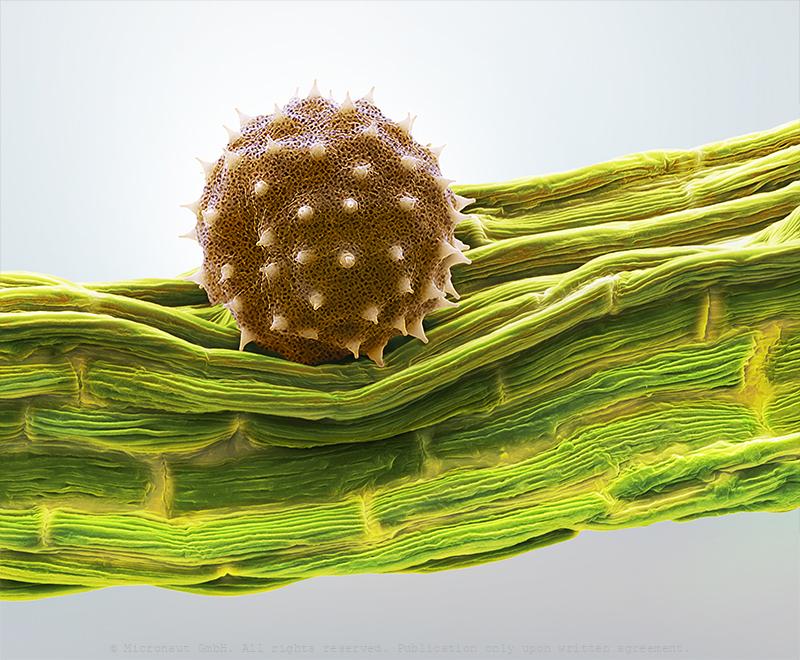
Pollen (Abutilon sp.)
Abutilon pollen is medium to large in size and has a spiny exine surface.
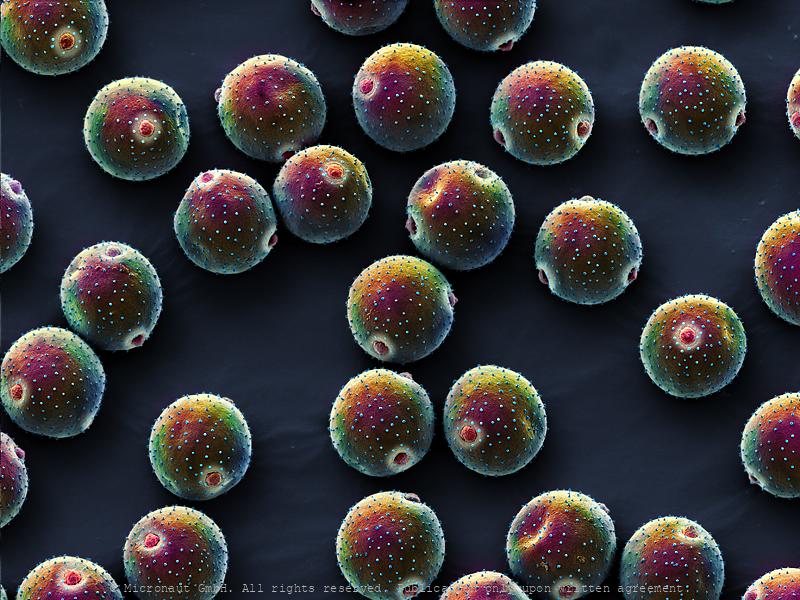
Bellflower pollen
The Blue-purple bellflower is a rare endemic plant from the island of Mauritius became a legend in the late 1980ies when it was found to produce red nectar. Before, botanists exclusively spoke of nectar as clear sugar water. The plant produces spherical pollen grains with spikes.
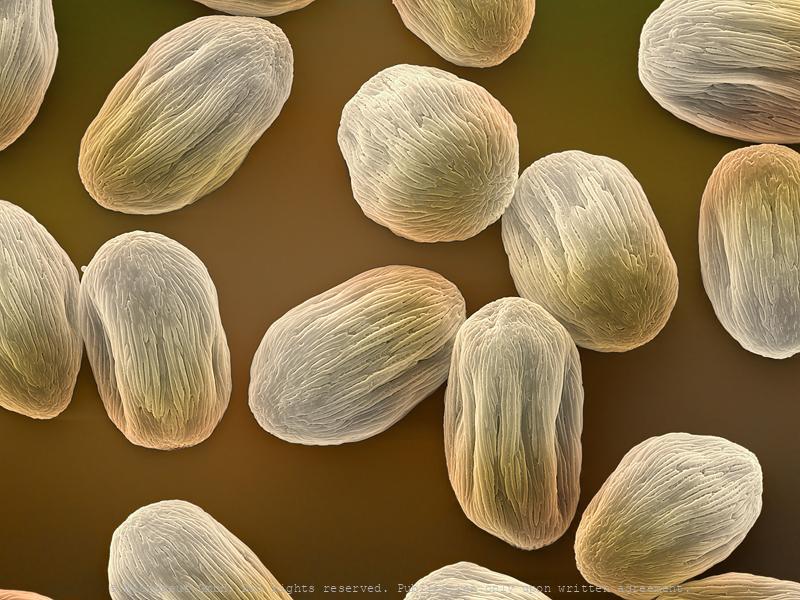
Angel's Trumpet pollen (Brugmansia sanguinea)
The Angel's trumpet (Brugmansia sanguinea) produces up to 15 cm long flowers and is usually pollinated by the amazing Sword-billed Hummingbird, with a bill as long as it's head and body. All parts of the plant are poisonous, containing tropan alcaloids, with (S)-scopolamin and (S)-hyoscyamin at the highest concentrations.
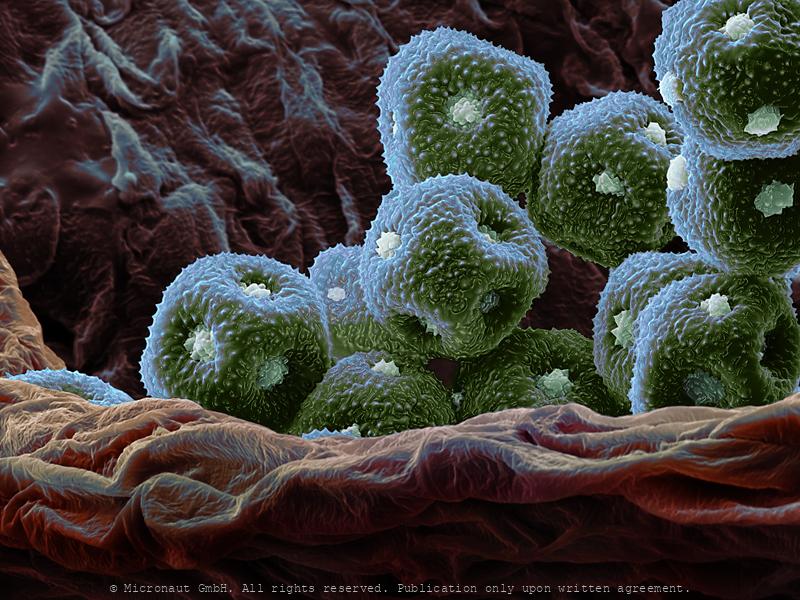
Burhead pollen (Echinodorus paniculatus)
Burhead (Echinodorus paniculatus) pollen grains as they emerge from the anther.
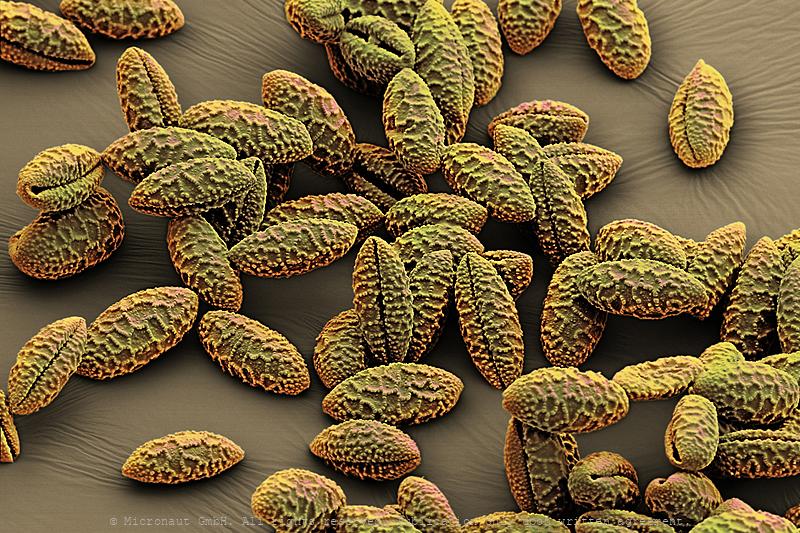
Pollen (Lily)
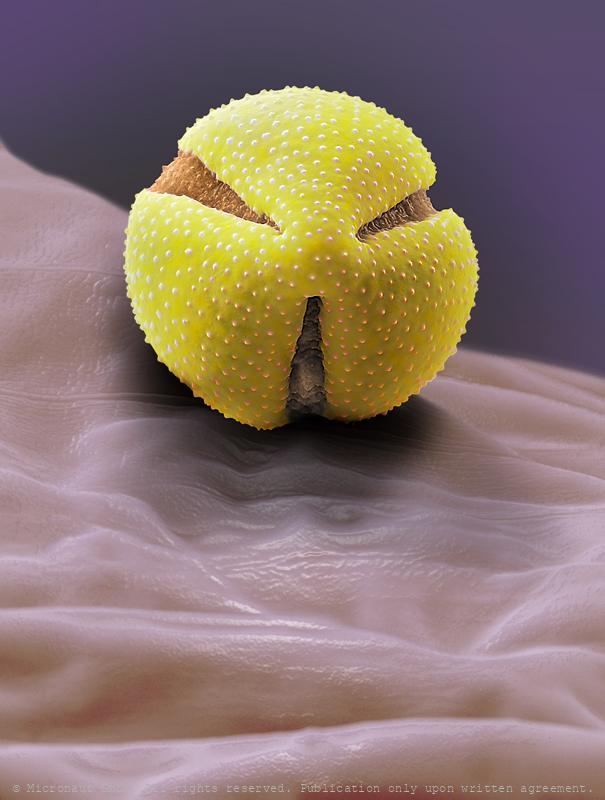
Winter aconite pollen (Eranthis hyemalis), Nr.1
This single pollen grain of a Winter aconite (Eranthis hyemalis) is loosely attached to the surface of the pistil.
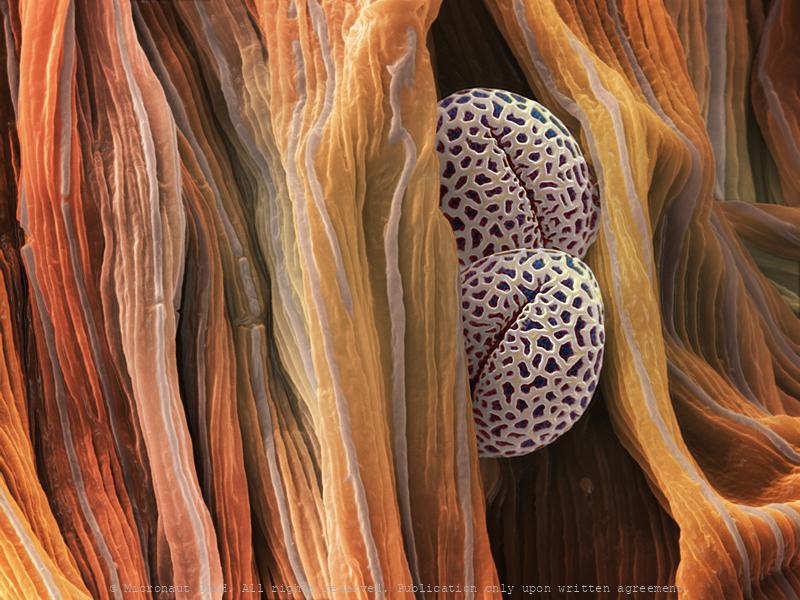
Pollen (Ilex sp.)
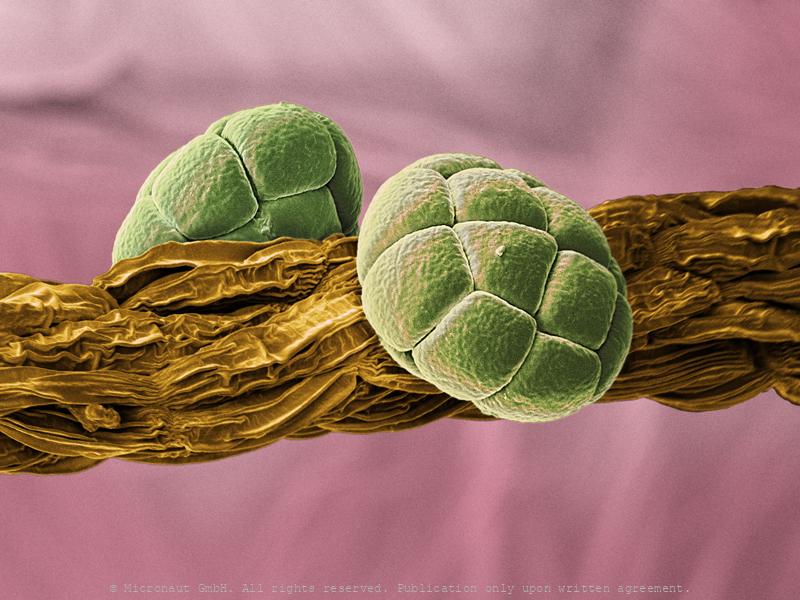
Pollen (Acacia sp.)
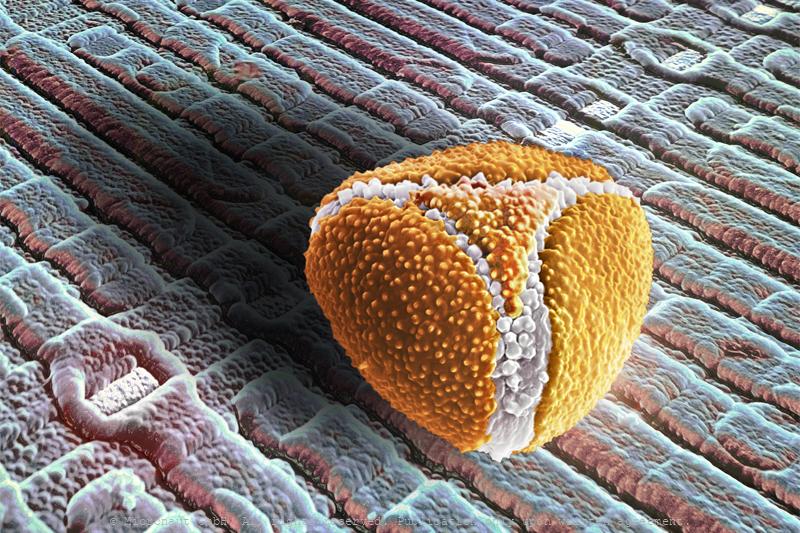
Pollen on a chip (Aponogeton sp.)
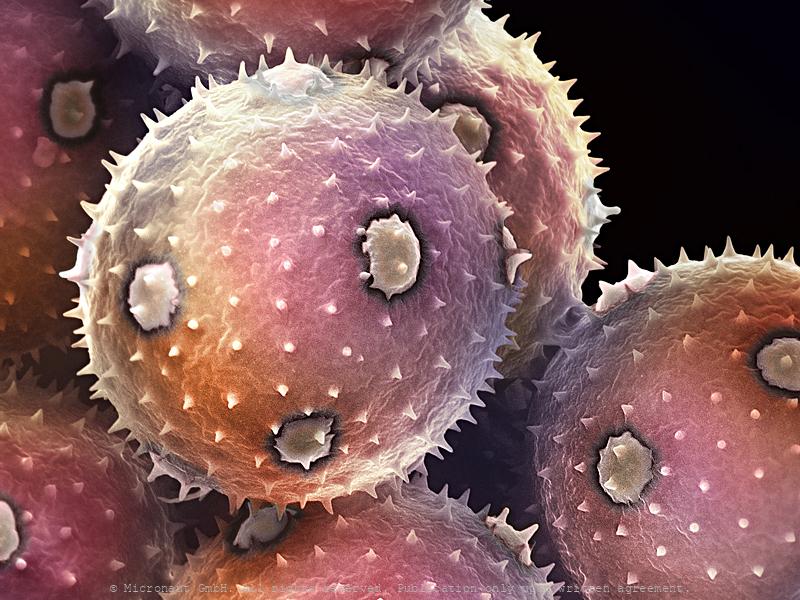
Pollen (Cucurbita sp.)
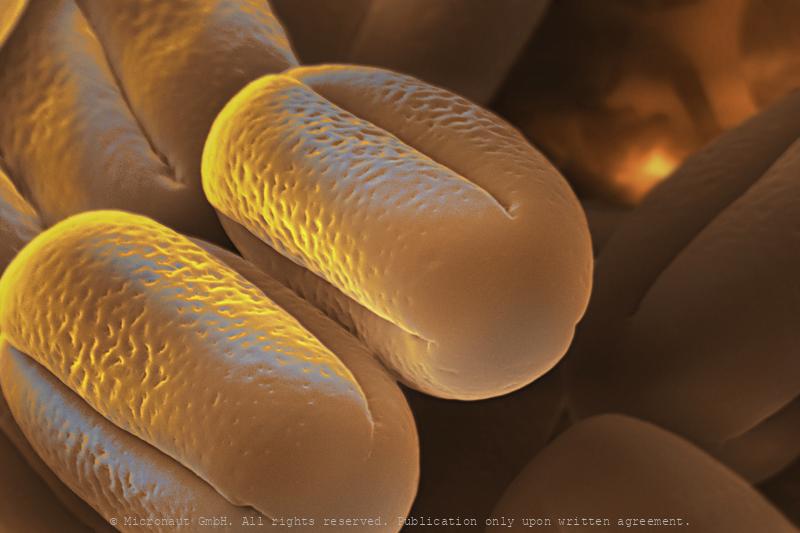
Pollen (Trifolium sp.)
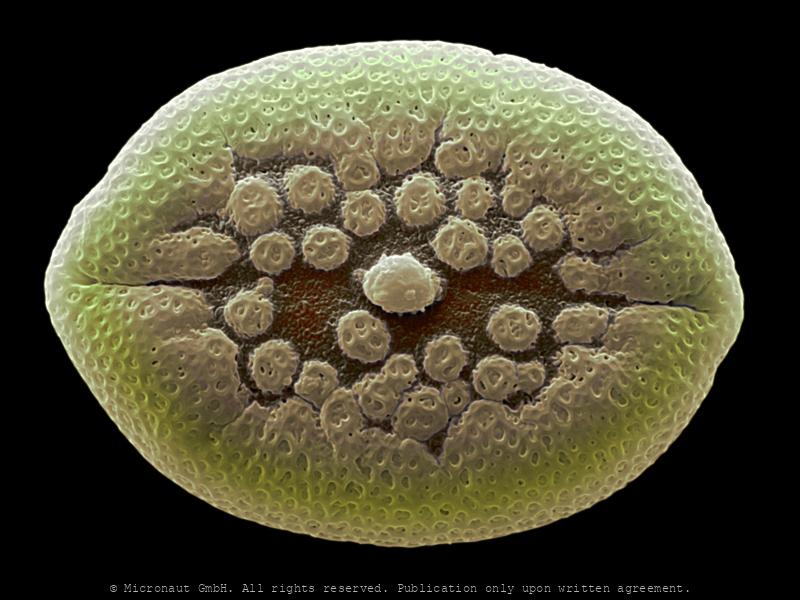
Pollen (Justizia rizzinii)
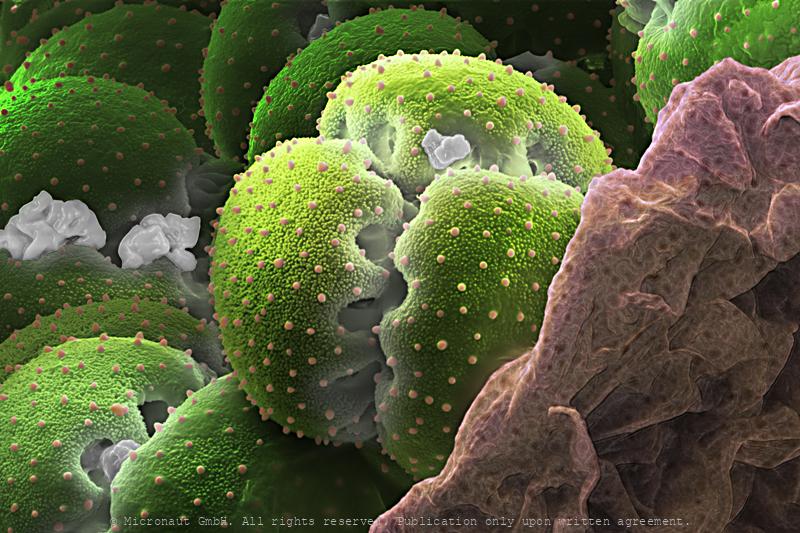
Venus fly trap pollen (Venus sp.)
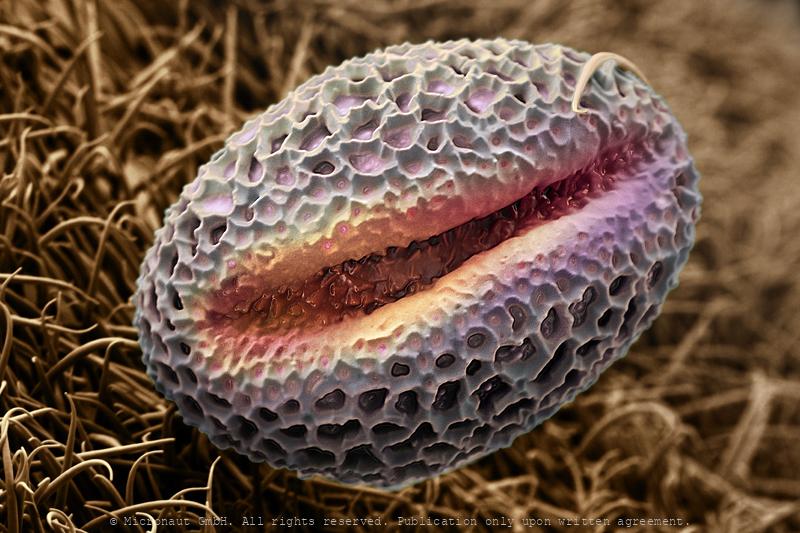
Pollen on insect (unknown species)
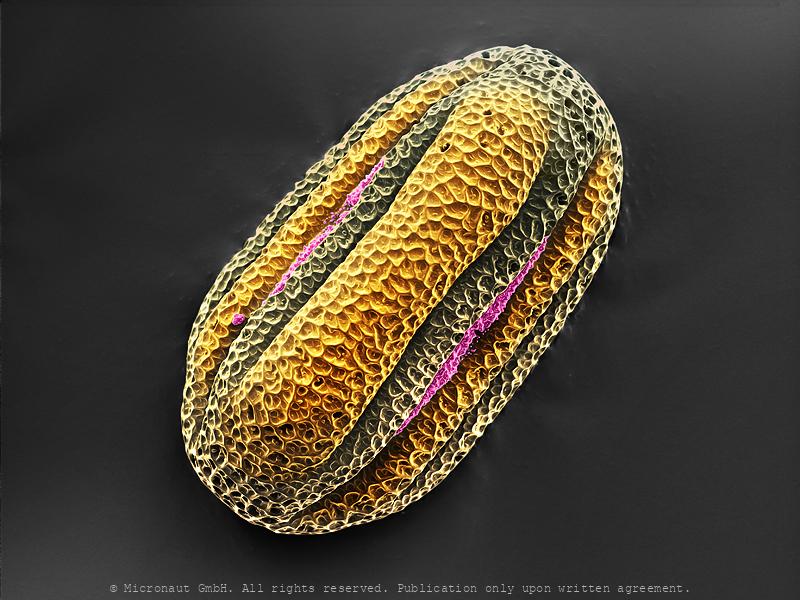
Pollen
Dry pollen grains often show preformed clefts that allow extreme volume changes accompanying desiccation and hydration. Some of them additionally serve as portals for pollen tube exit during germination and are called apertures.
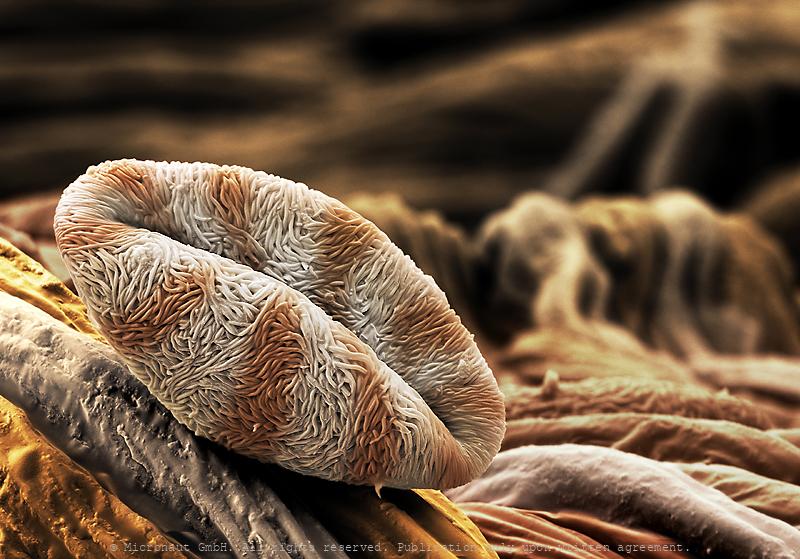
Quinche pollen, Nr.1
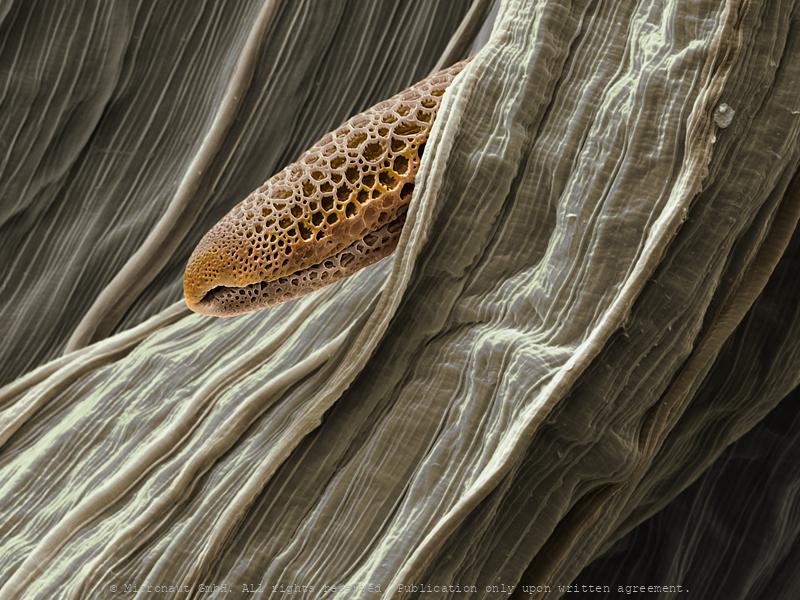
Tillandsia pollen (Tillandsia sp.)
Dry pollen grains often show preformed clefts that allow extreme volume changes accompanying desiccation and hydration. Some of them additionally serve as portals for pollen tube exit during germination and are called apertures. They are highly variable in size, number and complexity. Pollen grains from monocotyle plant species, as for example those from tropical epiphytes, usually possess only a single meridional cleft, which spans along the entire length.
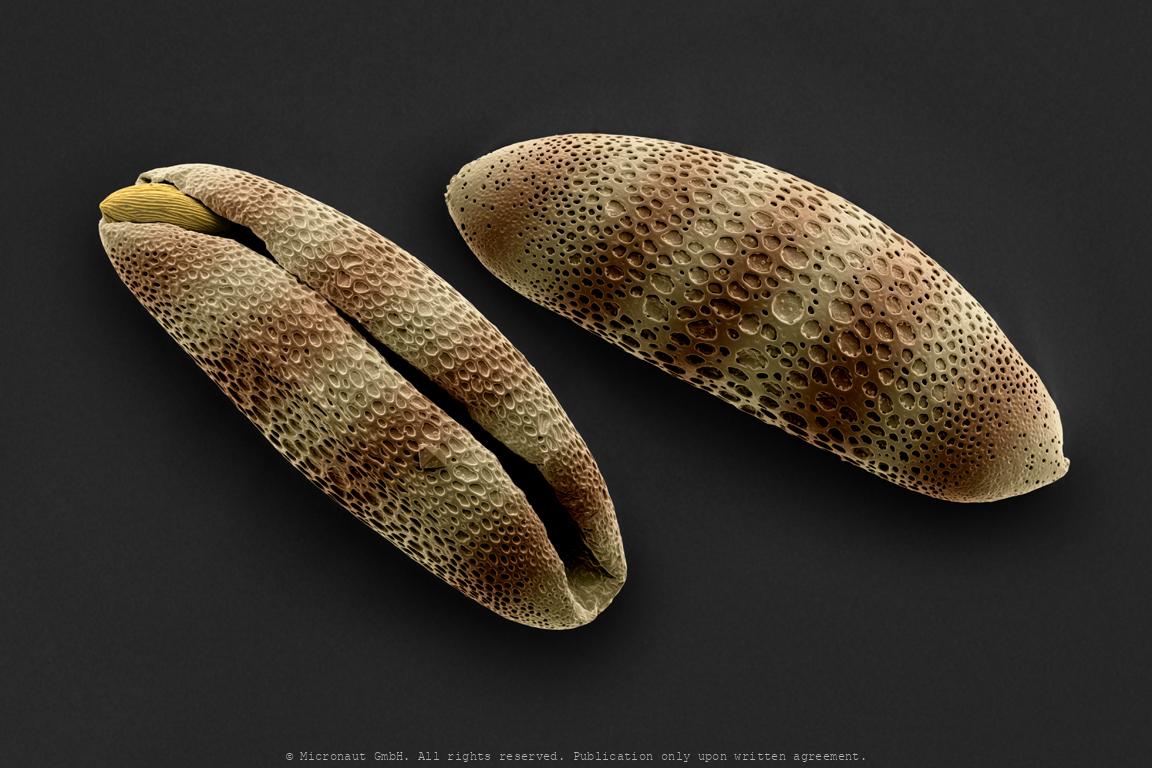
Pollen
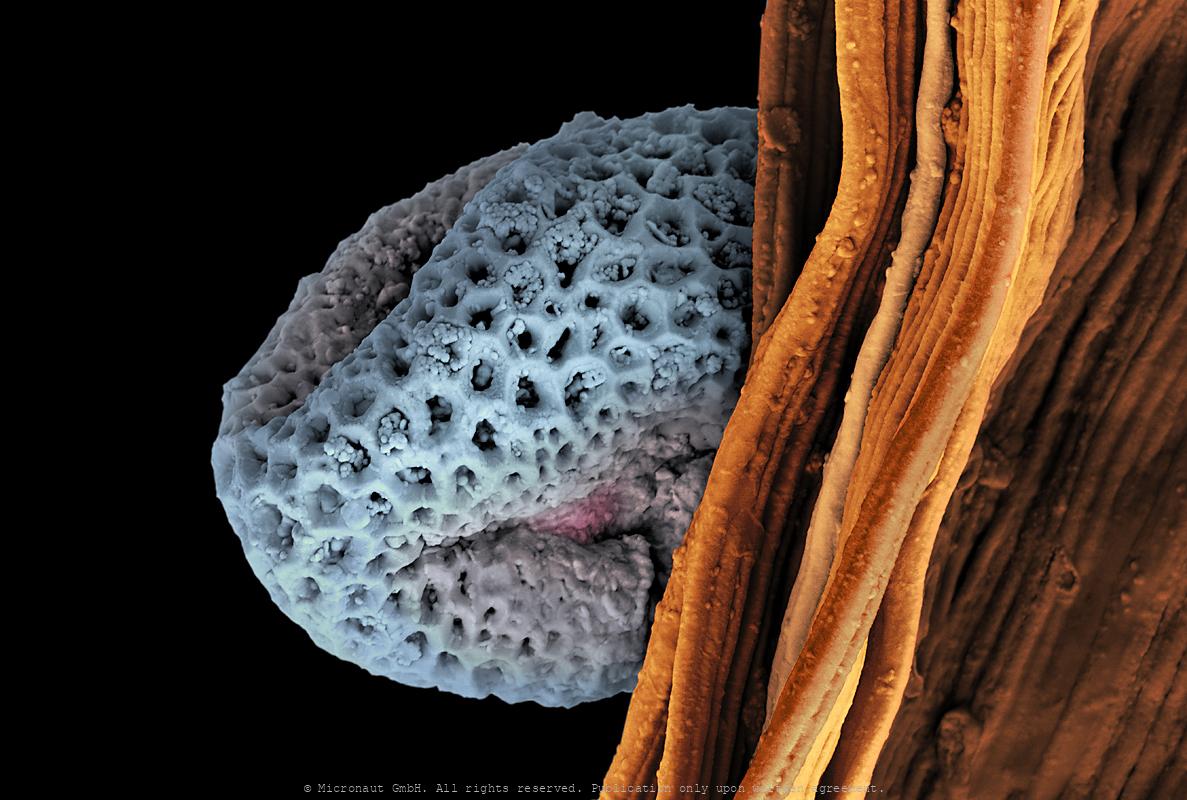
Pollen (Tulipa sp.)
A single pollen grain of a Tulip (Tulipa sp.) has attached to the pistil and starts to germinate. Eventually, the pollen tube will grow out of the cleft (=aperture), and turn to grow straight into the female reproductive tissue, to grow towards the ovules.
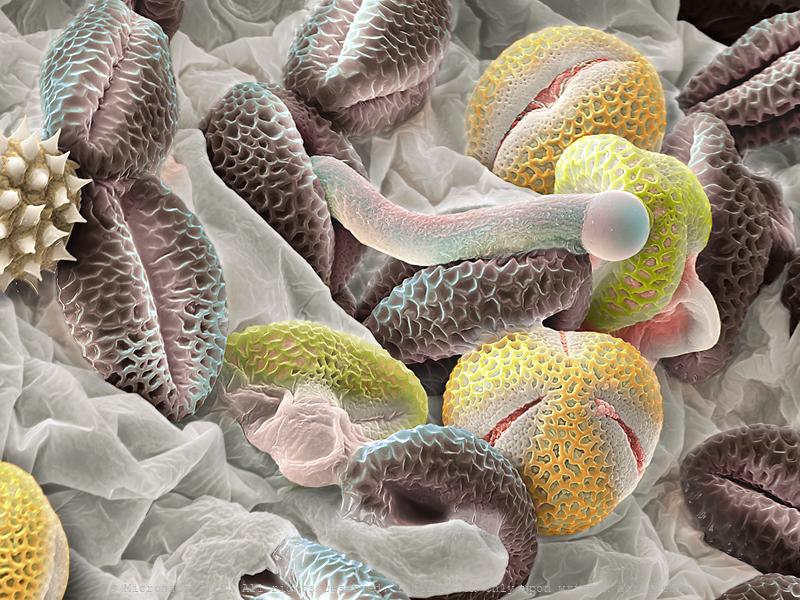
Fertilization race starts on a snowball blossom
As soon as pollen grains land on a stigma, the competition for successful fertilization starts. Complex biochemical interactions between stigma surface and pollen coat allow only the compatible pollen to hydrate, germinate and project a tube into the stigma. While numerous pollen tubes wind their way, only one will eventually enter the micropyle opening of the ovule, to fertilize the egg.
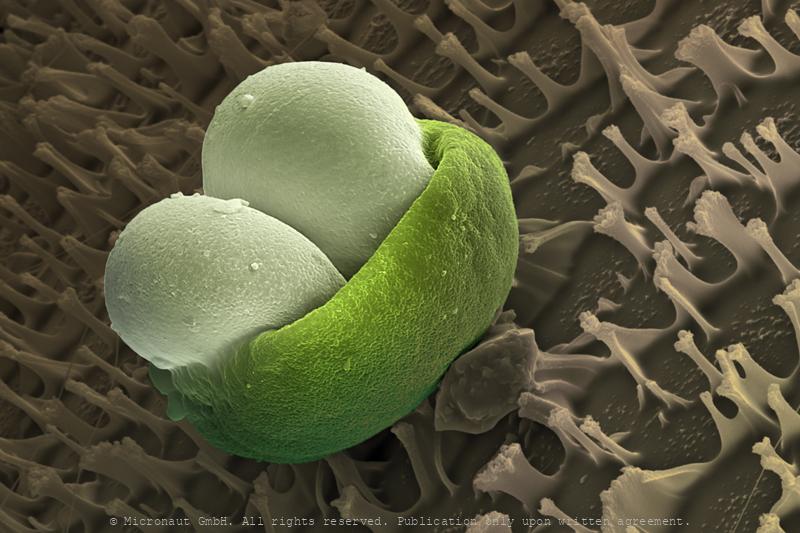
Pine pollen (Pinus sylvestris), Nr.1
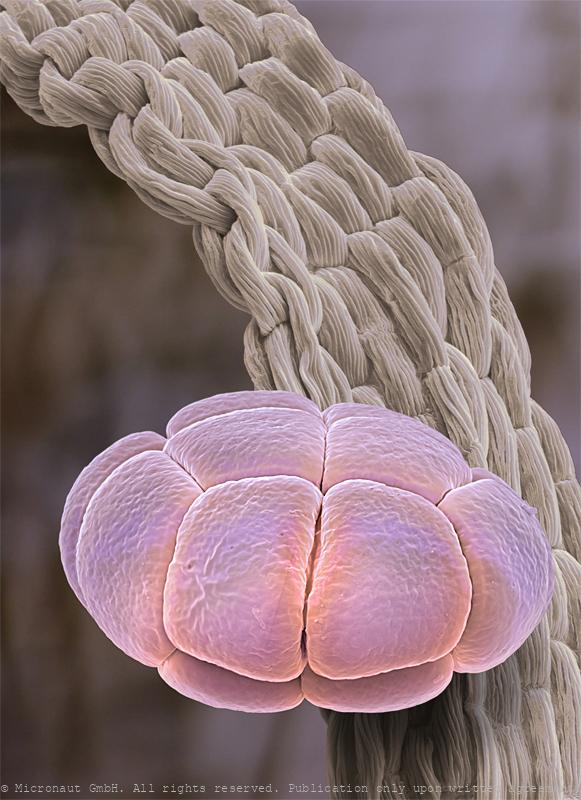
Pollen (Albizia julibrissin)
While the conventional pollen is a perfect whole, no suitable term exists for this unusually shaped pollen grain. The Persian Silk Tree and its relatives from the Acacia- family have evolved complex pollen made of many different parts. The image shows a pollen sticking to an anther. Mimosa (Albizia julibrissin) has been used for many years in Chinese Medicine to treat anxiety and depression, and its Chinese name He Huan Pi (Hua) translates to "collective happiness flower".
Micronaut images are rights-managed. If you want to get a quote, please contact us, providing the following information: (1) image name, (2) specific use, (3) industry, (4) distribution area, (5) format, (6) circulation or print run, and (7) duration.
Please note that we cannot answer incomplete requests. Thank you.
